
Poultry is the backbone of our staff meals for largely the same reasons it is in other families—it’s inexpensive, always available, and highly adaptable. We enjoy exploring a wide range of ethnic cooking, and chicken’s mild taste often serves as a blank canvas when we’re experimenting and trying out a combination of unfamiliar seasonings. Many of the recipes in this chapter are equally delicious made with other types of domesticated poultry, such as turkey or duck, or with such game birds as pheasant, guinea hen, and partridge. Rabbit, too, can be substituted for chicken with great success in stewed or braised dishes. Although we don’t often splurge on rabbit or game birds for our own meals, they’re favorites on the Chanterelle menu.

This simple, comforting chicken dish will fill your home with the autumnal aroma of roasting sweet potatoes, parsnips, and apples. The sweet, earthy flavors of the cider and sturdy root vegetables complement one another perfectly, giving added character and depth of flavor to the bird. Serve with a simple green salad. SERVES 4
1 chicken (3½ pounds)
2 tablespoons unsalted butter
2 firm, tart apples, such as Granny Smith, cored, peeled, and cut into 1-inch dice
1 large sweet potato, peeled and cut into 1-inch dice
1 medium onion, cut into 1-inch dice
1 large parsnip, peeled and cut into 1-inch rounds
2 medium carrots, peeled and cut into 1-inch rounds
½ medium head cauliflower, cut into florets
Coarse (kosher) salt and freshly ground black pepper, to taste
2 cups apple cider
1. Preheat the oven to 400°F.
2. Rinse the chicken, inside and out, under cold running water, removing any excess fat. Pat dry with paper towels. Place the chicken in a flameproof roasting pan large enough to hold it and the vegetables without crowding. Smear the chicken skin with the butter, then surround it with the apples and vegetables, sprinkle everything with salt and pepper, and pour in the cider.
3. Place the roasting pan in the oven and roast the chicken and vegetables until the apples have practically melted away, the vegetables are browned and tender, and the chicken juices run clear when a thigh is pricked with a fork, 1¼ to 1½ hours. Stir the vegetables halfway through the roasting time so they brown evenly.
4. Carefully remove the chicken to a platter. Using a slotted spoon, remove the vegetables and place them around the chicken; cover to keep warm. Set the roasting pan over high heat and bring the cider and roasting juices to a boil over high heat, scraping up the browned bits on the bottom of the pan. Cook, uncovered, until the liquid is reduced by half, 5 to 10 minutes.
5. Remove the pan from the heat, taste for seasoning, and pour the sauce into a gravy boat. Serve the sauce to accompany the chicken. Carve the chicken in the kitchen or at the table.
how to render chicken fat
If you make roast chicken or chicken stock fairly often, it takes little extra effort to have a supply of rendered chicken fat (schmaltz) on hand for use in recipes such as chopped chicken liver and borscht. There’s always surplus fat to be trimmed from whole chickens, especially from the neck, body cavity, and tail areas. I save the bits of fat in the freezer, adding to my cache until I have at least a cup or two. To render fat, defrost it slightly, cut into ½- or 1-inch pieces, and place them in a heavy skillet or saucepan over low heat. Add about ¼ cup water (to prevent the fat from sticking) and cook gently, stirring occasionally, until the fat has liquefied and the solids have shrunk and become crispy brown bits, about 10 to 15 minutes. Let the fat cool slightly before straining it through a fine-mesh strainer into a storage container with a tight-fitting cover. (In Yiddish the crunchy pieces left behind are called gribenes, and in the old days before cholesterol was declared the enemy they were considered quite a treat.) Store rendered fat in the refrigerator for a month or in the freezer for up to a year. To render duck or goose fat, follow the same procedure.

This chicken classic is a tribute to the transformational power of heat. Although raw garlic is pungent and aggressive, slow-roasted garlic is the complete opposite—it’s gloriously sweet and mellow. When this dish comes out of the oven, each buttery-soft clove has become a subtle complement to the perfectly roasted chicken. SERVES 6 TO 8
2 chickens (3 to 3½ pounds each)
2 tablespoons rendered chicken fat or unsalted butter
Coarse (kosher) salt and freshly ground black pepper, to taste
6 heads garlic, blanched and peeled (see box, page 145)
2 cups dry white wine
2 cups Chicken Stock (page 39) or canned low-sodium chicken broth
1 teaspoon fresh lemon juice
3 tablespoons unsalted butter, cut into pieces
1. Preheat the oven to 450°F.
2. Rinse the chickens, inside and out, under cold running water, removing any excess fat. Pat dry with paper towels. If you wish, tuck the wing tips under the second joints and tie the legs together with butcher’s twine.
3. Rub the chickens all over with the chicken fat or butter and sprinkle, inside and out, with salt and pepper. Place the birds in a flameproof roasting pan that can hold them with a little extra room to spare. Roast for 30 minutes, basting occasionally with pan drippings.
4. Add the garlic to the roasting pan, then reduce the oven temperature to 400°F and continue roasting for 15 to 20 minutes more, basting and stirring up the garlic cloves occasionally.
5. Add the wine to the roasting pan and continue roasting the chickens until they’re just done (a thigh pricked with a fork will release clear juices), 15 to 20 minutes more. Transfer the chickens to a platter and keep warm, covered loosely with aluminum foil, while you prepare the sauce.
6. Put the roasting pan containing the garlic and cooking liquid on top of the stove, over two burners, if possible. Add the chicken stock and bring to a boil over high heat, scraping up the browned bits on the bottom of the pan. Cook until the liquid is reduced by about half, 10 minutes. Add the lemon juice and swirl in the butter until melted and incorporated. The sauce should thicken enough to coat the back of a spoon. Remove from the heat and season with salt and pepper.
7. To serve, cut the chickens into serving pieces and pour the sauce and garlic cloves over them.

how to peel forty cloves of garlic
It’s not as time consuming as you think. To separate a head of garlic into cloves, place it root-end up on a flat surface and press forcefully down with the palm of your hand to loosen the cloves. Cut off the stringy roots, then separate the individual cloves from the head and blanch them in boiling water for 1 minute. Put the cloves in a colander and run cold water over them; the skins should slip off easily.
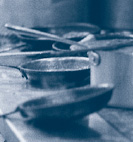
This technique—creating a boldly seasoned butter that’s “stuffed” or massaged under the skin of a whole chicken—results in a moist, succulent bird that’s crisp skinned and flavorful. The melting butter bastes the chickens as they roast, while the herbs remain nestled under the skin, slowly releasing their fragrance into the meat. Any combination of herbs or seasonings that pleases you can be used, from fresh tarragon or tapenade to curry powder or roasted red peppers. The chickens taste great hot out of the oven but are even better carved and served at room temperature with a simple tomato salad. SERVES 6 TO 8
2 chickens (3 to 3½ pounds each)
3 large cloves garlic, peeled
2 cups fresh basil leaves, rinsed and patted dry
2 large shallots, peeled
1 cup (2 sticks) unsalted butter, at room temperature
2 teaspoons coarse (kosher) salt
¼ teaspoon freshly ground black pepper
Juice of ½ lemon
1. Rinse the chickens, inside and out, under cold running water, removing any excess fat. Pat dry with paper towels. Set aside.
2. Combine the garlic, basil, shallots, butter, salt, pepper, and lemon juice in a food processor or blender and process until smooth. Refrigerate until the mixture firms slightly, about 30 minutes.
3. Preheat the oven to 450°F.
4. Starting at the lower end of the breast on each chicken, slide your fingers under the skin and work to loosen it as much as possible over the breast and thighs, being careful not to tear it. Set 4 tablespoons of the butter mixture aside for rubbing on the outside of the chickens. Stuff the remainder under the skin of the chickens, spreading it as evenly as possible over the flesh and pressing down on the outside of the skin to distribute it further.
5. If you wish, tuck the wing tips on each chicken under their second joints and tie the legs together with butcher’s twine. Rub the chickens with the reserved butter mixture and place in a roasting pan just large enough so the chickens fit without touching. Roast for 20 minutes, then reduce the oven temperature to 350°F and continue roasting, basting the chickens occasionally with pan drippings, until the juices run clear when one of the thighs is pierced by a fork, 30 to 40 minutes more.
6. Transfer the chickens to a platter and let them rest for a few minutes before carving and serving.

waste not, want not
Like any frugal home cook, a good professional cook uses almost everything, throwing out as little as possible. We transform stale bread into croutons and bread crumbs; leftover vegetables become soup ingredients; and chicken livers—well, at Chanterelle they’re a delicious reason to make chopped chicken liver. Next time you roast a chicken, don’t just unthinkingly toss out that little bag inside it that contains the liver, neck, gizzard, and heart. Open it up, sort the pieces, and freeze them. I keep a separate zipper-lock bag for livers in the freezer and another for those other parts that will come in handy when I make chicken stock. It’s like money in the bank.

The same dark and intriguing broth used to make Chilled Red-Cooked Beef (page 65) will also transform a whole chicken into an unforgettable eating experience. As I roam around New York’s Chinatown grocery shopping, I often see rows of these reddish brown chickens hanging in restaurant windows; they’re called Soy Sauce Chicken on the restaurant menus. Make the broth from scratch or use the reserved master broth you tucked away in the freezer after making the beef version. Either way, be sure to take into account that the chicken needs to marinate for 24 hours; this is not a recipe to make on the spur of the moment. Also note that while dried shiitakes and dried orange peel usually require presoaking, this is unnecessary here due to the broth’s long simmering time.
Serve this as part of an Asian-inspired buffet-style light supper that includes Soba Salad (page 337), Stir-Fried Rice Noodles with Bean Sprouts and Scallions (page 282); a platter of Ginger Pickled Vegetables (page 343), a bowl of Spicy Green Dipping Sauce (page 151), a pot of Dijon mustard, and a plate of fresh pineapple for dessert.
Since we’re all hot-sauce fans at Chanterelle, there’s nearly always an assortment of hot sauces set out on the staff-meal table when this is served. One of my favorites, Camel brand Chili Bean Sauce from China, is made with fermented black beans and adds just the right accent to red-cooked chicken or beef shin. It’s also delicious with fried chicken. SERVES 8 AS AN APPETIZER
Broth for Red-Cooking (page 67)
Asian sesame oil, for brushing
Fresh cilantro leaves, for garnish
1. Rinse the chicken, inside and out, under cold running water, removing any excess fat. Pat dry with paper towels.
2. Place the unstrained broth in a very large stockpot and bring to a boil over high heat. Add the chicken and return the liquid to a boil. Reduce the heat to low and simmer, partially covered, for 30 minutes.
3. Remove the pot from the heat and let the chicken cool in the liquid, then refrigerate the chicken, still in the liquid, for 24 hours.
4. To serve, remove and discard the hardened layer of fat from on top of the cold broth, then remove the chicken from the broth, scraping off whatever spices and bits of jellied broth are clinging to it (see Note). Cut the chicken into 10 pieces (see page 159), but it’s best if you can cut it even smaller (the breast in eighths, the thighs in quarters, the legs in half, and the wings in half as well) and arrange on a platter. Just before serving, brush the chicken lightly with sesame oil and garnish with cilantro.
Note: The broth will become richer and more flavorful over time, and can be used over and over again, supplemented with additional stock, water, or seasonings as needed. Transfer the broth to a container with a tight cover (don’t strain it) and refrigerate for up to a week, bringing to a boil every couple of days, or freeze for up to 6 months.
happy food
In the Chinese technique known as red-cooking, ingredients are simmered in an intensely flavored dark brown, nearly black cooking liquid that contains quite a lot of soy sauce. Since the braising liquid and the finished dish are really more brown or black than red in color, you might well wonder why the technique isn’t called brown-cooking. Unlike black or brown, which are considered unlucky colors in Chinese culture, red is a happy one symbolizing joy and celebration.

I think boiled chicken is vastly misunderstood; most people dismiss it as bland and uninspiring. This version, however, is subtly flavorful and astoundingly juicy. In a variation on a classic Chinese cooking technique known as white-cut, a whole chicken is simmered in an understated water-based broth that’s infused with sherry, scallions, and lots of sliced fresh ginger. Hot from the pot, the boiled chicken is plunged into an ice-water bath to cool off. This rapid cooling prompts the muscles of the meat to contract, ensuring that virtually all of the poultry’s natural juices are retained. Cut into small pieces, the succulent bits of chicken are accompanied by a bowl of lively Spicy Green Dipping Sauce (page 151) seasoned with Asian sesame oil, fresh cilantro, and jalapeño pepper.
I like to serve this as part of an Asian-inspired buffet for a light supper along with Cucumber Salad with Red Onion and Chinese Sausage (page 314), Marinated Tomatoes with Balsamic Vinegar and Basil (see box, page 344) or Beets with Balsamic Vinegar (page 306), and Soba Salad (page 337). SERVES 8 AS AN APPETIZER
1 chicken (3 to 3½ pounds)
8 quarts water
1 cup dry sherry
1 pound fresh ginger (unpeeled), rinsed and cut into ¼-inch pieces
3 bunches scallions, white and green parts, trimmed and cut into 1-inch pieces
Fresh cilantro leaves, for garnish
Spicy Green Dipping Sauce (recipe follows)
1. Rinse the chicken, inside and out, under cold running water, removing any excess fat.
2. Combine the water, sherry, ginger, and scallions in a large stockpot. Bring to a boil over high heat and continue boiling for 10 minutes. Carefully add the chicken, return to a boil, reduce the heat to low, and simmer, covered, until the chicken is just tender, 45 minutes to 1 hour.
3. A few minutes before the chicken is done, set a very large bowl in the kitchen sink and fill it with water and plenty of ice. Carefully remove the chicken from the pot, letting the stock drip back into the pot. Immediately submerge the chicken in the ice-water bath to cool. Remove the chicken as soon as it’s cool to the touch, after about 15 to 20 minutes; do not soak any longer than necessary. If you aren’t sure it has cooled sufficiently, insert a metal skewer into the thickest part of the chicken—it should be cool to the touch when removed.
4. To serve, cut the chicken into at least 10 pieces (see box, page 159)—though it’s best if you cut it even smaller (the breast in eighths, the thighs in quarters, the legs in half, and the wings in half as well)—and arrange on a platter. Garnish with the cilantro and serve accompanied by the dipping sauce.
Set out little bowls of this flavorful sauce not only for white-cooked chicken but as a dip for carrot sticks, crisp jicama slices, and other favorite raw vegetables as well. MAKES ABOUT ¾ CUP
¼ cup tightly packed cilantro leaves and stems, finely chopped
1 tablespoon finely grated fresh ginger
1 large jalapeño pepper, seeded and chopped (about 1 tablespoon)
1 tablespoon Asian sesame oil
2 teaspoons coarse (kosher) salt
½ cup canola or peanut oil
1. Place the cilantro, ginger, jalapeño, sesame oil, and salt in a small heatproof bowl.
2. Place the canola oil in a small saucepan and heat over low heat until very hot but not smoking (a drop of water should sizzle when dropped into the oil). Carefully pour the heated oil into the bowl of cilantro mixture. Stir to combine and let cool to room temperature before serving.

The flavors of Provence—tomatoes, onions, garlic, and olives—were my inspiration for this robust dish, which can be quickly made with succulent little Cornish hens. To me, olives are Provence. I like to use Moroccan oil-cured olives in this sauce because they’re wonderfully salty and meaty, but you could just as easily choose little brine-cured French Niçoise olives or Greek Kalamatas. Serve this with garlic-roasted potatoes and a dish of green beans or broccoli. SERVES 2 TO 4
2 Cornish hens (1 to 1½ pounds each)
2 to 3 tablespoons olive oil
1 medium onion, sliced lengthwise
2 cloves garlic, minced
1 cup canned crushed tomatoes or tomato sauce
½ cup dry white wine
½ cup Chicken Stock (page 39) or canned low-sodium chicken broth
½ cup pitted black olives, preferably Moroccan oil-cured
½ teaspoon dried thyme leaves
¼ teaspoon hot red pepper flakes
Coarse (kosher) salt, to taste
2. Remove the wing tips and backbones from the Cornish hens and discard, or save them for stock. Rinse the hens, inside and out, under cold running water, removing any excess fat. Cut the hens into quarters and pat dry with paper towels.
3. Heat 2 tablespoons of the oil in a large, deep cast-iron or other ovenproof skillet over medium-high heat. When it just begins to smoke, add the hen quarters, skin-side down, and sauté until well browned on all sides, about 4 minutes per side. Using tongs, transfer the hens to a platter and set aside.
4. If the oil looks burnt, wipe out the skillet and add another tablespoon of oil. Heat over medium heat, then add the onion and sauté, stirring, just until it looks a little frizzled, about 1 minute. Add the garlic and sauté until fragrant but not browned, 30 seconds more. Add the tomatoes, wine, stock, olives, thyme, pepper flakes, and salt and bring to a boil.
5. Return the Cornish hens to the skillet and place in the oven. Bake, uncovered, until the hens are cooked through (the juices will run clear when a thigh is pricked with a fork) and a nice sauce has formed, about 20 minutes. Serve immediately, directly from the skillet.
luscious little birds
Rock Cornish hens, also known as Rock Cornish game hens, are actually very young chickens that are 4 to 5 weeks old. They’re a hybrid, a cross between the White Rock chicken—which accounts for their full breasts—and the flavorful Cornish hen. Until a few years ago their average weight was around a pound, but these days you’re more likely to find them weighing between 1½ and 2 pounds. Their relatively smaller size makes these tasty birds ideal for serving two, or one diner with a hearty appetite.

Every family has at least one recipe with a silly name that’s rarely as amusing to outsiders as it is to family members. This is the Waltucks’. One day as I was making this chicken potpie at home, I began singing that old childhood tune, “Jimmy crack corn and I don’t care.” A few minutes later, to the amusement of our children, it had new lyrics—“Chicken potpie and I don’t care.”
Potpies are one of those straightforwardly homey dishes that everyone loves. They shouldn’t be messed around with too much. Using roast rather than poached chicken makes a more flavorful dish. Occasionally I use the dough for Herbed Biscuits (page 382) for the crust, and at times I may add leeks, sautéed mushrooms, or fresh corn in season, but that’s as much gussying up as it gets. If you like, the potpie can be frozen uncooked, then baked unthawed in a 350°F oven. SERVES 4 TO 6
1 chicken (3 to 3½ pounds)
Coarse (kosher) salt, to taste
6 cups Chicken Stock (page 39) or low-sodium chicken broth
2 large waxy potatoes, such as Yukon Gold, unpeeled, cut into ½-inch dice
3 medium carrots, peeled and cut into ½-inch rounds
3 tablespoons unsalted butter
3 tablespoons all-purpose flour
½ teaspoon dried thyme leaves
1 bay leaf
Freshly ground black pepper, to taste
½ cup frozen peas
½ recipe Pastry Dough (recipe follows)
1 large egg, beaten
2. Rinse the chicken, inside and out, under cold running water, removing any excess fat. Pat dry with paper towels. Sprinkle the chicken, inside and out, lightly with salt, then place in a shallow roasting pan and roast until the juices run clear when a thigh is pricked with a fork, about 1¼ hours.
3. Meanwhile, bring the chicken stock to a boil in a medium-size saucepan over medium-high heat. Add the potatoes and reduce the heat to medium low. Cook, covered, until they are just tender, 5 to 8 minutes. Using a slotted spoon, transfer the potatoes to a bowl. Add the carrots to the simmering stock and cook, covered, until they are just tender, about 5 minutes. Remove from the heat and, using the slotted spoon, transfer the carrots to the bowl with the potatoes and set aside. Reserve the stock for use in the sauce.
4. Melt the butter in a small saucepan over medium-low heat. Whisk in the flour and cook, continuing to whisk, until the mixture gives off a nutty aroma but isn’t browned, about 10 minutes. Whisk in the reserved stock, then add the thyme and bay leaf and season with salt and pepper. Cook the sauce over low heat, whisking frequently, until thickened enough to coat the back of a spoon, about 5 minutes. Remove the saucepan from the heat and let cool to room temperature, stirring occasionally.
5. When the chicken is done, remove the roasting pan from the oven and transfer the chicken to a platter. Reduce the oven temperature to 400°F. When the chicken is cool enough to handle, peel off and discard the skin, then pull the meat from the bones. Discard the carcass or set aside to use for stock. Cut the meat into ¾-inch dice and place in a medium-size casserole, along with the reserved potatoes and carrots and the peas (unthawed is fine). Toss gently but thoroughly to mix. Remove the bay leaf from the sauce and pour over the mixture in the casserole, tossing gently to coat. Set aside.
6. Using a lightly floured rolling pin, roll out the pastry on a lightly floured work surface to a thickness of about ¼ inch. Cut the pastry to fit the top of the casserole with a 1-inch overhang (see Note). Brush the edge with some of the beaten egg, then carefully transfer the pastry to the top of the casserole, flipping it so the egg edge is on the underside. Press the edge of the pastry against the casserole. The egg should help seal the pastry well. Cut a few slits in the pastry, brush it all over with beaten egg, and bake the pie until the filling is bubbling and the crust is golden brown, 30 minutes. Serve immediately.
Note: You may have too much pastry, depending on the type of casserole you’re using. A deeper casserole will take less pastry; a shallow one will have a wider top and take more. I prefer a shallow casserole, because I like a higher ratio of crust to filling.
This is a good sturdy yet tender pastry, perfect for chicken potpies. In fact, it’s a good crust for any sweet or savory pie. MAKES ENOUGH FOR TWO 9-INCH SINGLE-CRUST PIES OR ONE DOUBLE-CRUST PIE
3 cups all-purpose flour
Pinch of coarse (kosher) salt
1 cup (2 sticks) very cold unsalted butter, cut into small pieces
½ to ¾ cup ice water
1. Combine the flour and salt in a food processor (see Notes) and pulse several times just to mix. Sprinkle the pieces of butter over the mixture and pulse the machine until the butter gives the flour a mealy texture.
2. With the machine running, drizzle in the water through the feed tube, starting with ½ cup, then pulse just until the water is incorporated. The dough should be moist enough to form a ball but not be sticky. If the mixture seems dry, add more water, a tablespoon at a time. Divide the pastry in half and press into two flat disks, wrap them separately in plastic, and refrigerate for at least 1 hour before using (see Notes).
Notes: The pastry can also be made by hand, as follows: Whisk the flour and salt in a large bowl to mix, then cut in the butter, using a pastry blender or two knives, until the mixture resembles coarse meal. Sprinkle ½ cup of the water over the mixture and toss with a fork to mix. Use your hands to test a small portion of the dough; it should hold together but not be sticky. Add more water if necessary, a tablespoon at a time. Form, wrap, and refrigerate as directed above. The dough may be refrigerated for 2 to 3 days, and frozen for up to 3 months.

Over the years this delectable fried chicken, served with Creamed Spinach (page 340) and plenty of piping hot Herbed Biscuits (page 382), has been our most requested staff meal. Depending on the season and my mood, I sometimes make Summertime Creamed Corn (page 313) or Cider Vinegar Slaw (page 310) instead of spinach.
Fried chicken, like barbecue, is one of those quintessential American dishes that all home cooks and chefs are convinced they make better than anyone else. And I’m no exception. Marinating the chicken in buttermilk boldly seasoned with Tabasco and Doctored Harissa (page 368) has a tenderizing effect. The buttermilk also serves as a thick coating that absorbs more flour, which is the secret to moist and crunchy fried chicken. Double-coating further ensures a nice crisp crust. The marinated pieces are coated heavily in flour and refrigerated for an hour to give the marinade time to absorb the flour, then just before frying, the pieces are lightly coated again.
This fried chicken is just as delicious at room temperature as it is served hot from the frying pan. SERVES 6 TO 8
2 chickens (3 to 3½ pounds each)
4 cups buttermilk
¼ cup Tabasco sauce
2 tablespoons Doctored Harissa (page 368)
All-purpose flour, for coating
Vegetable oil, for frying
Coarse (kosher) salt, to taste
1. Rinse the chickens, inside and out, under cold running water, removing any excess fat. Cut each chicken into 8 pieces (see page 159) and pat dry with paper towels.
2. Combine the buttermilk, Tabasco, and harissa in a bowl or roasting pan large enough to hold all the chicken and whisk to blend. Add the chicken pieces, turning to coat, and refrigerate, covered, for at least 8 hours and up to 16, turning the pieces occasionally.
3. When you’re ready to proceed with the recipe, spread about 1½ cups flour in a shallow dish or pie plate. Dip each piece of chicken heavily in flour to coat on all sides and arrange, without touching, on a large platter or baking sheet. Refrigerate for an hour, letting the flour absorb the buttermilk mixture.
4. If you’re planning to serve the chicken hot, preheat the oven to its lowest setting. Line a large, shallow baking pan or rimmed baking sheet with paper towels.
5. Pour oil to a depth of ½ inch into a large, deep, heavy skillet and heat over medium-high heat until it’s almost smoking. Just before you add each piece of chicken to the hot oil, dip it again in the flour, lightly this time, shaking off any excess. Add only enough pieces to fit into the skillet without touching; don’t crowd the pan. Fry the chicken, turning as needed, until golden brown and cooked through, about 10 to 15 minutes per side (see Note). Using tongs or a slotted spatula, remove the chicken pieces to the lined baking pan and, if you’re planning to serve the chicken hot, place it in the oven to keep warm while you fry the remaining chicken. Continue to fry in batches, replenishing (and reheating) the oil in the skillet as necessary and placing each batch in the oven to keep warm.
6. When all the chicken is fried, sprinkle with salt, transfer to a serving platter, and serve hot or at room temperature.
Note: Test the pieces after 20 minutes. If some pieces are done before others (white meat cooks faster than dark), remove them from the skillet. Also, if the chicken is browning too quickly, adjust the heat. You want the chicken to hit the perfect crispness and color at the same time that the meat is cooked through.
cutting up a whole chicken
Supermarkets have made it easy to get chicken in whatever configuration you need, but I believe it’s best to buy a chicken whole and cut it up yourself. That way you know for sure where all the parts came from, and you’re more likely to have a fresher-tasting final product.
Most important for chicken cutting is a good sharp knife. If I’m preparing chicken pieces for anything except fried chicken, I use a boning knife. If I’m preparing a chicken for frying, I use a chef’s knife. Either way, cutting up a chicken can be greasy work, so be sure to keep plenty of paper towels around to wipe off your hands or the knife handle from time to time. Here’s how to cut up a chicken into 8 pieces (for general cooking):
Place the chicken on your work surface breast-side up, legs toward you. First remove a leg by locating the joint that attaches the leg to the body. Carefully cut through that joint. Divide the leg by cutting through the joint that attaches the drumstick to the thigh. Do the same thing with the other leg.
I like to remove the breast meat from the bone, leaving just the wing bones in. To do this, I work on one half of the breast at a time. Make a cut along one side of the breastbone near the wing end of the chicken. Ease the meat off that half of the breast by cutting down along the rib cage to the tail end of the chicken. Cut through the joint that attaches the wing to the body of the chicken and remove the breast meat half in one piece. Remove the wing tip, then divide the breast piece in half so that one half is completely boneless and the other includes the wing. Repeat this on the other side of the breast. You should have 8 pieces of chicken (4 breast pieces and 4 leg pieces).
If you’re preparing chicken for frying, start with the chicken backside up, tail end toward you. Use poultry shears to remove the backbone, cutting along each side from tail to head. Use a chef’s knife to split the chicken in half through the breastbone. Remove the legs, then separate them as described above. Divide the breast pieces in half so that two have the wing portion. The other two should have a good portion of the remaining white meat. You now have 8 pieces.
To get 10 pieces, simply remove the wings from the breast pieces. Or if the thighs are meaty enough, split them in two.
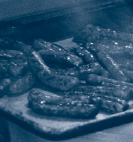
This nearly effortless one-pot meal was inspired by a steamed chicken dish I’ve often enjoyed in Cantonese restaurants, where it’s usually made with either sausage or mushrooms, but never both. Expanding the combination of ingredients results in a dark-colored, rustically flavorful dish perfumed with the earthy undertones of the shiitakes and the slightly sweet Chinese sausage. It’s long been a favorite with both the staff and my family. Our kids, Sara and Jake, are quite fond of it. In fact, for reasons I’ve been unable to pin down, so are most kids.
Be sure to use a casserole with a very tight-fitting lid; if it seems a bit loose, tightly cover the top with foil before putting on the lid. This dish tastes best the day it’s made. The steaming creates plenty of delicious sauce, so a big bowl of plain white rice is the only essential accompaniment. SERVES 6
25 dried shiitake mushrooms
1 chicken (3 to 3½ pounds)
6 Chinese sausages (see page 161), cut diagonally into ⅛-inch slices
¼ cup Chicken Stock (page 39) or canned low-sodium chicken broth
¼ cup oyster sauce, plus additional for serving
1 bunch scallions, white and green parts, trimmed and cut into ¾-inch lengths, plus additional for serving
1 piece (2 inches) fresh ginger, peeled, cut in half crosswise, and very finely julienned
1 tablespoon Asian sesame oil
2 tablespoons good-quality soy sauce, such as Kikkoman
1. Place the shiitake mushrooms in a large bowl with very warm water to cover. Let soak for 30 minutes to soften. Lift the mushrooms from the water, leaving the grit behind. Leave the mushrooms whole, trimming away any stems. Set the caps aside. Strain the soaking liquid through a strainer lined with several layers of cheesecloth. Cover, refrigerate, and save for use at another time.
2. Preheat the oven to 400°F.
3. Rinse the chicken, inside and out, under cold running water, removing any excess fat. Cut the chicken into 10 pieces (see box, page 159) and pat dry with paper towels.
4. Combine all the ingredients in a single layer, if possible, in a large, heavy casserole with a tight-fitting lid. Bake for 1 hour, then uncover and bake for 10 minutes more.
5. Remove the pan from the oven and skim off as much of the fat as possible. Sprinkle several tablespoons of oyster sauce and a small handful of scallion pieces over the top and serve.

chinese sausage
Chinese cured pork sausages (lop chong), which are a bit on the sweet side, are available at Chinese markets and some Asian specialty food stores. These hard sausages, usually red in color and about 6 inches long, are sold both in links (look for strings of them dangling in the meat section) and in vacuum-sealed packages. I prefer the kind labeled “with duck liver,” because these have a little earthiness to balance their sweetness. Before you use them, the sausages must be steamed or grilled.

Although our menu at Chanterelle is French in spirit, for our staff meals I love to experiment with a wide range of ethnic cuisines. I don’t claim authenticity for these forays into foreign territory; they’re my own versions of dishes I’ve enjoyed in restaurants or seen in books.
Authentic Hungarian paprika (see box) is absolutely crucial to the success of this vividly colored, intensely flavorful dish. In fact, if you have only domestic paprika in the cupboard, don’t bother making this until you have a tin of the real thing on hand. Serve the paprikás with rice, buttered egg noodles, or spaetzle. SERVES 6
2 chickens (3 to 3½ pounds each)
3 tablespoons rendered chicken fat (see page 143), bacon drippings, or canola or other vegetable oil
3 large onions, sliced
2 large cloves garlic, minced
¼ cup canola or other vegetable oil
3 tablespoons sweet Hungarian paprika, or more to taste
2 tablespoons hot Hungarian paprika, or more to taste
1 teaspoon tomato paste
3 cups Chicken Stock (page 39) or canned low-sodium chicken broth
1 bay leaf
1 tablespoon fresh lemon juice
Coarse (kosher) salt, to taste
2 cups crème fraîche or sour cream
1. Rinse the chickens, inside and out, under cold running water, removing any excess fat. Cut each chicken into 8 pieces (see page 159) and pat dry with paper towels. Set aside.
2. Melt the rendered chicken fat in a Dutch oven or large, heavy pot over low heat. Add the onions and garlic and cook slowly, stirring occasionally, until very soft and lightly golden but not browned, about 20 minutes.
3. Meanwhile, heat the oil in a large, heavy skillet over medium-high heat. When it just begins to smoke, add only enough chicken pieces to fit into the skillet without touching and sauté until well browned on all sides, about 4 minutes per side. Using tongs, transfer the chicken to a platter and set aside while you sauté the remaining pieces in batches, as necessary.
4. Add the sweet and hot paprikas and tomato paste to the onions and garlic in the pot and stir to coat thoroughly. Stir in the chicken stock and bay leaf and bring to a boil over medium-high heat. Add the chicken and, when the mixture returns to a boil, reduce the heat to low and simmer, covered, until the chicken is tender and cooked through, about 30 minutes.
5. Uncover the pot, increase the heat to medium, and return to a gentle boil. Add the lemon juice, salt, and more paprika, if you wish. Stir in the crème fraîche or sour cream, bring to a simmer (do not let it boil), and cook gently for 2 minutes to allow the flavors to blend, adjusting the heat as necessary to maintain the simmer.
6. Remove from the heat, adjust the seasoning one more time, and serve immediately.
hungarian paprika
The world’s finest paprika comes from Hungary, where it is processed mostly in the southern cities of Szeged and Kalocsa. Made from horn-shaped red chile pods (Capsicum annum) that have been dried and ground, this vivid powder comes in six strengths or grades ranging from delicate and minimally spicy to assertively hot and very spicy. The color, too, varies with each type, from orangey or bright red to a deep reddish brown. Sweet (also called noble sweet) and hot paprika are used for the recipes in this book. You’ll find that the Pride of Szeged brand, packaged in bright red tins, is sold at most super-markets and specialty food stores. (It deteriorates rapidly if exposed to air, heat, or light, and will last longer stored in the refrigerator.) Paprika is always used in generous amounts in Hungarian cooking, so don’t be alarmed at the

No matter how finely tuned or worldly our adult palates may become, each of us has favorite dishes from our childhoods that never fail to please. When Melicia was growing up, her grandmother and mother made this homey dish often. And Melicia carried on the tradition: When she joined the kitchen at Chanterelle, it was one of her first contributions to our staff meal. The light, fluffy dumplings are gently steamed on top of the simmering stew, allowing them to absorb all of the stew’s wonderful aroma and flavors as they puff up, creating the epitome of comfort food. SERVES 8
FOR THE STEW:
2 chickens (3 to 3½ pounds each)
2 tablespoons canola or other vegetable oil
2 small onions, diced
2 large cloves garlic, minced
1 cup dry white wine
8 cups Chicken Stock (page 39), canned low-sodium chicken broth, or water
1 teaspoon dried thyme leaves
3 bay leaves
10 grinds of black pepper
Small pinch of cayenne pepper
4 medium carrots, peeled and cut into ½-inch rounds
3 large white turnips, peeled and diced
Coarse (kosher) salt, to taste
FOR THE DUMPLINGS:
2 cups all-purpose flour
4 teaspoons baking powder
1 teaspoon snipped fresh chives
1 teaspoon chopped fresh flat-leaf parsley leaves
1 cup milk
Walnut-size piece of beurre manié (see box, page 62), chilled
1. Rinse the chickens, inside and out, under cold running water, removing any excess fat. Cut each chicken into 10 pieces (see box, page 159), and pat dry with paper towels.
2. Heat the oil in a large Dutch oven or large, wide, flameproof casserole over medium-high heat. When it just begins to smoke, add only enough chicken pieces to fit into the pot without touching and sauté until well browned on all sides, about 4 minutes per side. Using tongs, transfer the chicken to a platter and set aside while you sauté the remaining pieces.
3. When all the chicken pieces have been removed from the pot, add the onions and garlic and reduce the heat to medium low. Sauté, stirring occasionally, until the onions are softened but not browned, about 5 minutes.
4. Return the chicken to the pot, along with any accumulated juices, and add the wine. Increase the heat to medium high and bring to a boil. Cook, uncovered, until the wine is reduced by half, about 5 minutes, then add the chicken stock, thyme, bay leaves, black pepper, and cayenne. Bring to a boil, then reduce the heat to low and cook at barely a simmer, partially covered, until the chicken is almost done, about 1 hour, uncovering occasionally to skim any foam.
5. Add the carrots and turnips and continue simmering until the chicken is very tender and almost (but not quite) falling off the bone and the vegetables are tender, about 15 minutes.
6. Meanwhile, prepare the batter for the dumplings. Combine the flour, baking powder, salt, chives, and parsley in a medium-size bowl and whisk thoroughly to mix. Pour in the milk and stir to make a thick batter. Set aside.
7. Using a slotted spoon, gently transfer the chicken pieces to a bowl or platter and set them aside. Remove and discard the bay leaves. Taste the broth and add salt as necessary, then add the chilled beurre manié and whisk until it is completely incorporated and the liquid is somewhat thickened. Return the chicken to the pot and bring to a simmer.
8. Drop the dumpling batter by the tablespoonful directly onto the simmering stew. You should have sixteen dumplings. The dumplings will expand quite a bit, so don’t crowd them too much; leave about an inch between them. Cover tightly and simmer over low heat for exactly 15 minutes. Don’t be tempted to peek; after 15 minutes the dumplings will be perfect.
9. Remove from the heat and serve directly from the pot, or transfer the chicken and vegetables to a platter, surrounding them with the dumplings and spooning the sauce over everything.
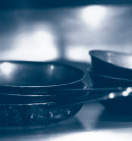
Chicken and tarragon are a classic pairing in French cuisine, one that results in succulent, subtle, and refined dishes. In this recipe the gutsier, bistrolike flavors of garlic, vinegar, and tomato invigorate the delicate aniselike presence of fresh tarragon.
When you’re adding the sauce to the chicken, try not to completely cover the meat. The goal is to create tenderly braised pieces of chicken without losing the textural contrast of crisp chicken skin. Roasted new potatoes and sautéed zucchini are the perfect accompaniments. SERVES 6
2 chickens (3 to 3½ pounds each)
3 tablespoons olive oil
2 large cloves garlic, minced
½ cup Chicken Stock (page 39) or canned low-sodium chicken broth
1 can (28 ounces) whole tomatoes, undrained
¼ cup tarragon vinegar, or more as necessary
3 tablespoons unsalted butter, or more as necessary
2 teaspoons roughly chopped fresh tarragon leaves
Coarse (kosher) salt and freshly ground black pepper, to taste
1. Rinse the chickens, inside and out, under cold running water, removing any excess fat. Cut the chickens into 8 pieces each (see box, page 159) and pat dry with paper towels. Set aside.
2. Heat the oil in a large, heavy, nonreactive skillet over medium-high heat. When it just begins to smoke, add only enough chicken pieces to fit into the skillet without touching and sauté until well browned on all sides, about 4 minutes per side. Using tongs, transfer the chicken to a platter and set aside while you sauté the remaining pieces in batches, as necessary.
3. When all the chicken has been removed from the skillet, add the garlic to the drippings and sauté over medium heat until fragrant but not browned, about 15 seconds. Add the wine and chicken stock and bring to a boil over medium-high heat, scraping up the browned bits stuck to the bottom of the pan. Return the chicken to the skillet along with any accumulated juices and boil the liquid until it’s reduced by half, about 5 minutes.
4. Add the tomatoes to the skillet, along with about half the juice in the can, ¼ cup vinegar, and 3 tablespoons butter. Return to a boil, stirring occasionally, then reduce the heat to medium low and simmer, uncovered, until the chicken is cooked through and the sauce has thickened somewhat, about 20 minutes; turn the chicken pieces once or twice during the cooking time and break up the tomatoes somewhat with your spoon. The sauce should hold together but still be rather chunky.
5. Remove the skillet from the heat and add the fresh tarragon and salt and pepper. Taste and adjust the seasoning, adding more butter if the sauce is too sharp and more vinegar if it isn’t sharp enough. Serve the chicken in the skillet or transfer to a platter, topping it with the sauce.
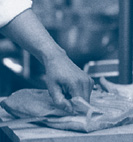
I first made this chicken dish when Karen and I were vacationing in Puerto Rico, staying in a cozy rented cottage on a small, pretty island off the coast with our children, Sara and Jake. Although Karen and I love to travel, having small children has changed the way we vacation. Now, rather than experiencing a local cuisine through restaurants, we focus instead on the tastes and smells of the food markets, carrying back to our temporary kitchens whatever looks interesting and different. But even a sparsely stocked market can inspire a dish. This vibrant stew makes the most of a few simple ingredients and takes advantage of the piquant saltiness of the green olives and capers I found as I roamed our island, thinking about what we’d eat for dinner. SERVES 6 TO 8
2 chickens (3 to 3½ pounds each)
¼ cup extra-virgin olive oil
3 medium bell peppers (can be a combination of red and green), stemmed, seeded, and cut into ¼-inch-wide lengthwise strips
2 medium onions, finely chopped
1 piece (4 ounces) slab bacon, rind removed, cut into small dice
2 cloves garlic, minced
2 cups Chicken Stock (page 39) or canned low-sodium chicken broth
2 cups canned tomato purée
2 cups chopped pitted green olives, with some of their liquid
1 cup dry white wine
¼ cup small (nonpareil) capers, with some of their liquid
4 bay leaves
Pinch of ground cinnamon
Coarse (kosher) salt, to taste, if necessary
1. Rinse the chickens, inside and out, under cold running water, removing any excess fat. Cut the chickens into 8 pieces each (see box, page 159), and pat dry with paper towels.
2. Meanwhile, heat the oil in a Dutch oven or large, heavy pot over medium-high heat. When it just begins to smoke, add half the chicken pieces and sauté until well browned on all sides, about 4 minutes per side. Using tongs, transfer the chicken to a platter and set aside while you sauté the remaining pieces.
3. When all the chicken has been removed from the pot, add the bell peppers, onions, bacon, and garlic to the drippings and reduce the heat to low. Sauté gently, stirring occasionally, until everything is very soft but not browned, about 15 minutes.
4. Return the chicken to the pot along with the chicken stock, tomato purée, olives (with some liquid), wine, capers (with some liquid), bay leaves, and cinnamon. Increase the heat to medium high and bring to a boil, then reduce the heat to low and simmer, partially covered, until the chicken is tender and cooked through, about 30 minutes.
5. Remove the pot from the heat, discarding the bay leaves. Taste and adjust the seasoning, adding salt or more liquid from the olives or capers as necessary. Serve immediately.

As is true in most restaurants, Chanterelle’s staff is like a miniature United Nations. For many years our dishwasher was a man from the Dominican Republic, and because this colorful, festive-looking dish was one of his favorites at our staff meals, we began calling it Dominican Chicken and Rice, although there’s nothing especially Dominican about it. Slices of chorizo, a spicy cured sausage often used in Spanish and Mexican cooking, add extra zip to the flavor. If unavailable, you can substitute pepperoni. SERVES 6 TO 8
2 chickens (3 pounds each)
¼ cup canola or other vegetable oil
3 tablespoons olive oil
2 medium onions, sliced lengthwise
2 medium red bell peppers, stemmed, seeded, and cut into lengthwise strips
2 large cloves garlic, minced
3 cups rice
½ cup dry white wine
1 can (28 ounces) whole tomatoes, undrained
3 cups Chicken Stock (page 39) or canned low-sodium chicken broth
2 teaspoons coarse (kosher) salt
½ teaspoon saffron threads (see box, page 174)
¼ teaspoon ground turmeric
2 bay leaves
½ cup black olives, preferably Kalamata
6 ounces chorizo or other spicy smoked sausage, cut into ¼-inch slices
Freshly ground black pepper to taste
½ cup frozen peas
1. Rinse the chickens, inside and out, under cold running water, removing any excess fat. Cut each chicken into 8 pieces (see box, page 159) and pat dry with paper towels.
2. Heat the canola oil in a large, heavy skillet over medium-high heat. When it just begins to smoke, add only enough chicken pieces to fit into the skillet without touching and sauté until well browned on all sides, about 4 minutes per side. Using tongs, transfer the chicken to a platter and set aside while you sauté the remaining pieces in batches, as necessary.
3. When all the chicken has been removed from the skillet, pour out the drippings and wipe out the skillet. Add the olive oil to the skillet and heat over medium heat. Add the onions, bell peppers, and garlic and sauté until the onions are softened but not browned, about 5 minutes. Remove the skillet from the heat and scrape its contents into a Dutch oven or large, heavy pot.
4. Add the rice to the skillet and cook, stirring, over low heat until opaque and very lightly browned, about 8 to 10 minutes. Transfer the rice to the pot.
5. Add the wine to the skillet and bring to a boil over high heat, reducing the liquid by half and scraping up any browned bits, about 3 minutes. Add the tomatoes, chicken stock, salt, saffron, turmeric, and bay leaves and bring to a boil over medium-high heat, stirring occasionally. Transfer the tomato mixture to the pot. Nestle the chicken in the pot and scatter the olives and chorizo slices over the top. Reduce the heat to low and cook, covered, for 20 minutes.
6. Uncover and taste the rice for seasoning, adding salt and pepper. Scatter the peas over the top, then cover once more and continue cooking until the rice and chicken are tender and the peas are heated through, 5 minutes more.
7. Remove the pot from the heat. Discard the bay leaves before serving the chicken and rice.

converted rice
The version of parboiled long-grain rice known as converted rice is the one made famous by Uncle Ben. Unlike regular white rice, from which the hull and layers of bran have been almost totally milled, this type has been pressure-steamed prior to milling, which forces some of the otherwise lost nutrients back into the center of the grain. During processing, the grain’s starch is also gelatinized and, as a result, the pale buff-colored rice cooks up fluffy and tender, with well-separated grains that don’t stick together. It’s likely that the idea of parboiling rice originated centuries ago in India; in fact, many Indian curry recipes specify converted or parboiled rice, because it’s important that the grains not clump together.
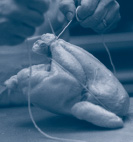
This staff favorite was inspired by a recipe I saw years ago in one of Paula Wolfert’s classic cookbooks. The North African combination of preserved lemons and olives makes for a particularly succulent dish, with the chicken taking a real backseat to the pleasantly pungent sauce. The cooking aromas alone are enough to drive us all to distraction in the kitchen.
I prefer to make my own preserved lemons, but if you have access to a specialty food shop that carries commercial brands, save yourself the trouble and buy a jar or two. SERVES 6 TO 8
2 chickens (3 pounds each), with their livers
4 medium onions, either grated or chopped in a food processor until almost puréed
3 cloves garlic, finely chopped
½ cup olive oil
2 cups Chicken Stock (page 39) or canned low-sodium chicken broth
1½ teaspoons hot Hungarian paprika
½ teaspoon saffron threads (see box, page 174)
½ teaspoon ground ginger
¼ teaspoon ground coriander
3 bay leaves
2 Preserved Lemons (recipe follows), or as needed
1½ cups black olives, such as Kalamata
1 tablespoon fresh lemon juice, or more to taste
Coarse (kosher) salt, to taste
4 tablespoons (½ stick) unsalted butter, cut into pieces
Chopped flat-leaf parsley leaves, for garnish
Cilantro sprigs, for garnish
1. Trim the chicken livers, then rinse and drain well. Process the livers in a blender or food processor until puréed; set aside.
2. Rinse the chickens, inside and out, under cold running water, removing any excess fat. Cut the chickens into 8 pieces each (see box, page 159) and pat dry with paper towels. Set aside.
3. Combine half the grated onions with all the garlic, oil, chicken stock, paprika, saffron, ginger, coriander, and bay leaves in a large, heavy pot and bring to a boil over high heat. Reduce the heat to low and simmer for 15 minutes to develop the flavors.
4. Stir in the puréed chicken livers and the remaining onions, then add the chicken pieces. Increase the heat to medium and, when the mixture simmers, reduce the heat to low and cook, covered, until the chicken is very tender, 30 to 45 minutes.
5. Meanwhile, remove and discard the inner pulp from the preserved lemons, then finely chop enough of the pith and skin to make about ½ cup. Setting ½ cup of the olives aside for garnish, pit and coarsely chop the remainder.
6. When the chicken is tender, transfer it to a platter, using tongs, and set aside. Add the preserved lemons, chopped olives, and 1 tablespoon lemon juice to the pot. Bring the mixture in the pot to a boil over high heat and cook, uncovered, until it has thickened somewhat and the flavors have concentrated, about 5 minutes.
7. Remove the pot from the heat and discard the bay leaves. Season with salt and maybe a bit more lemon juice, if desired. Return the chicken to the pot, along with the butter. Set over low heat and bring to a simmer. Cook, uncovered, stirring occasionally, until the butter is melted and completely incorporated and the chicken is heated through.
8. Serve in the pot or transfer the chicken to a deep platter and pour the sauce over. Garnish with the chopped parsley, cilantro sprigs, and whole olives and serve immediately.

Since it’s pretty hard to find preserved lemons (although they are available in Middle Eastern markets and some specialty food stores), I’m including instructions for their preparation here. MAKES 5 PRESERVED LEMONS
15 lemons (5 to preserve, 10 for juice)
¼ to ½ cup coarse (kosher) salt
1 tablespoon whole coriander seeds
2 teaspoons whole black peppercorns
1. Scrub 5 lemons thoroughly under cold running water and pat dry with paper towels. Cut a deep X in each, starting at one end and cutting almost but not quite through to the other end; the lemons will be quartered but still attached at one end. Sprinkle the cut sides with a little salt.
2. Choose a widemouthed ceramic, glass, or plastic container for preserving the lemons. Sprinkle some salt, some coriander seeds, and some peppercorns over the bottom. Add the prepared lemons, cut-sides down, to the container, packing them in tight. If you have to do this in layers, sprinkle more of the spices between the layers, ending with a sprinkling on top of the final layer.
3. Squeeze the remaining 10 lemons to yield about 2 cups juice. Pour the juice over the lemons to cover, then weight the lemons down with a small plate to keep them from floating. Cover the container tightly and refrigerate for 3 weeks before using.
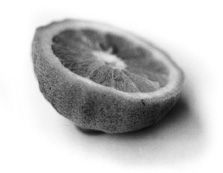
about saffron
Saffron is one of the world’s most expensive spices—and worth every penny! Here’s how to get the most flavor and color from each precious filament before adding it to the dish you’re preparing. Place the saffron in a small bowl and cover it with a little hot water or warmed stock or red or white wine. Let the saffron soak for at least 10 minutes before using. Do not drain; just pour the saffron and soaking liquid into the dish you’re preparing.

This version of a classic Italian hunter’s-style chicken and mushroom fricassee goes a bit easy on the tomatoes but is earthily redolent of mushrooms, red wine, and garlic. I use button and portobello mushrooms, but any combination would be delicious. For a more intense and woodsy mushroom flavor, soak a few dried porcinis in warm water for an hour or so, then add them along with their flavorful strained soaking liquid to the ingredients in step 3. Serve with roasted new potatoes or fettuccine or orzo, and Caesar salad. SERVES 4
1 chicken (about 3½ pounds)
3 tablespoons olive oil
4 small portobello mushroom caps (about 6 ounces), wiped clean and sliced
1 medium onion, sliced lengthwise
2 cloves garlic, minced
10 ounces small fresh cultivated white mushrooms, wiped clean, trimmed, and quartered
1 cup hearty red wine
1 cup Chicken Stock (page 39) or canned low-sodium chicken broth
1 cup Tasty Basic Tomato Sauce (page 271) or canned peeled tomatoes, drained and diced
1 teaspoon dried oregano leaves
¼ teaspoon hot red pepper flakes
3 bay leaves
Coarse (kosher) salt, to taste
1. Preheat the oven to 400°F.
2. Rinse the chicken, inside and out, under cold running water, removing any excess fat. Cut the chicken into 10 pieces (see box, page 159) and pat dry with paper towels.
3. Heat the oil in a large, deep, cast-iron or other ovenproof skillet over medium-high heat. When it just begins to smoke, add only enough chicken pieces to fit into the skillet without touching and sauté until well browned on all sides, about 4 minutes per side. Using tongs, transfer the chicken to a platter and set aside while you sauté the remaining pieces in batches, as necessary.
4. When all the chicken pieces have been removed from the skillet, add the portobellos and onion to the drippings and sauté, stirring occasionally, over medium-high heat until softened and lightly browned, about 3 minutes. Add the garlic and sauté, stirring, until fragrant but not browned, 1 minute or less.
5. Add the white mushrooms, wine, chicken stock, tomato sauce, oregano, pepper flakes, bay leaves, and salt and bring to a boil. Nestle the chicken pieces in among the mushrooms, leaving some of the browned chicken skin above the liquid, then transfer the skillet to the oven. Cook, uncovered, until the chicken is cooked through (the juices will run clear when a thigh is pricked with a fork), about 30 minutes.
6. Remove and discard the bay leaves, then taste and adjust the seasoning. Serve immediately, directly from the skillet.

Dishes like this 1950s banquet favorite may seem corny, even irretrievably retro, but greet them with an unprejudiced palate and you just might be surprised at how really good some seemingly hackneyed recipes taste. Besides, how could anyone go wrong with chicken layered with slightly sweet ham and blue cheese, the whole thing breaded and sautéed to a warm golden brown?
I love blue cheese, but you may substitute goat cheese or revert to a more traditional Swiss cheese or Gruyère. SERVES 8
4 whole skinless, boneless chicken breasts (about 3 pounds total)
8 slices good-quality deli ham
8 ounces good-quality blue cheese, crumbled into large pieces
Freshly ground black pepper, to taste
1 cup all-purpose flour
2 cups fine dry bread crumbs (see box, page 279)
3 large eggs
3 tablespoons canola or other vegetable oil
1. Rinse the chicken under cold running water, then pat dry with paper towels. Cut the breasts in half, removing any excess fat and cartilage. Remove the chicken tenderloin from each piece and reserve them for another use (see Note). Cut each breast piece in half horizontally through its thickness. You should have 16 thin cutlets.
2. Place a cutlet between two sheets of waxed paper and pound gently with a meat pounder or rolling pin to make it an even thickness. Do this with the remaining cutlets.
3. Place 8 cutlets out on your work surface. Top each of the cutlets with 1 piece of ham. Divide the cheese among the cutlets, sprinkling it on evenly over the ham. Sprinkle pepper to taste over the cheese. Top each of the layered cutlets with one of the remaining cutlets.
4. Spread out the flour and bread crumbs on separate plates. Beat the eggs lightly in a shallow bowl.
5. Carefully dip each chicken “sandwich” in the flour to coat on all sides, shaking off any excess. Then dip each in the eggs. Lastly, dip the chicken in the bread crumbs to coat completely. Place each sandwich as it is coated on a large platter, arranging them so they don’t touch. If you have the time, refrigerate the platter, uncovered, for 1 to 2 hours to let the coating dry.
6. Heat the oil in a large, heavy skillet over medium heat. Add the chicken sandwiches and sauté until golden brown and the chicken is cooked all the way through, about 4 minutes per side. Serve immediately.
Note: The chicken tenderloin is the fillet-type piece that is lightly attached to the underside of the breast.

This was one of Melicia’s favorite staff meals to cook because the reaction is always so satisfying—the staff simply loves it. Now that Melicia is no longer at Chanterelle, I’ve taken her lead and continue to make it as part of the staff-meal repertoire. I think you, too, will find this unexpected use of couscous interesting and tasty. The couscous is stuffed underneath the breast skin so that with each bite you get a forkful of moist meat, fragrantly spiced couscous, and crispy skin.
For an attractive-looking presentation on the plate, serve the chicken with vegetables of contrasting colors, such as glazed carrots and steamed spinach. SERVES 4
1½ cups couscous
2 teaspoons extra-virgin olive oil
¾ cup very hot water
6 tablespoons (¾ stick) unsalted butter
¼ cup minced onion
1½ tablespoons Madras-style curry powder
1 tablespoon fresh lemon juice
Coarse (kosher) salt
3 dashes of Tabasco sauce
¼ cup toasted pine nuts (see page 399)
¼ cup dried currants
2 whole chicken breasts (1½ to 1¾ pounds each), with skin and bone
1. Place the couscous in a medium-size bowl and drizzle the olive oil over it to help keep the grains separate. Stir the couscous around until all the grains are coated with the oil. Gradually pour in the hot water, stirring as you go. When all the water has been added, let the couscous rest, stirring every few minutes, until the water is absorbed and the couscous is tender, 15 minutes.
2. Melt 4 tablespoons of the butter in a 10-inch skillet over medium-low heat. Add the onion and cook gently, stirring occasionally, until soft and translucent but not browned, about 5 minutes. Add the curry powder and cook, stirring, 2 minutes more. Be careful not to brown the curry powder or it will become bitter.
3. Add the couscous to the skillet and mix well. Stir until the couscous is hot, about 2 minutes, then add the lemon juice, ½ teaspoon salt, the Tabasco, pine nuts, and currants. Taste the couscous; it should be highly seasoned. Transfer the mixture to a bowl and let it cool to room temperature.
4. Preheat the oven to 400°F.
5. Rinse the chicken under cold running water, then pat dry with paper towels. Split each breast in half, making sure the skin is evenly divided between the two pieces. Starting from the wing socket, gently run your finger in between the skin and meat to make a pocket, being careful not to pull the skin away from around the edges.
6. Using a spoon, stuff the couscous under the skin, filling each breast piece nicely with a mound of the mixture. Try not to pull the skin away from the meat as you do this—but if you do, just smooth the skin over the stuffing as best you can. It’s hard to do this neatly, but when you’re finished, wipe off any couscous sticking to the outside of the breast.
7. Place the stuffed breasts on a baking sheet, dot them with the remaining 2 tablespoons butter, and sprinkle with salt. Roast until the skin is nicely browned and crisp and the chicken is done, about 30 minutes (the juices should run clear when a small cut is made in the thickest part of the breast). If the skin has browned well and the meat is still underdone, place a loose tent of aluminum foil over the chicken to prevent further browning and cook 5 minutes more before checking again. Serve immediately.
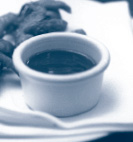
Sometimes you need only replace a commonplace ingredient with an uncommon one to transform an ordinary recipe into something special. In this instance, breading narrow strips of chicken breast with panko—Japanese-style bread crumbs—rather than standard coarse dry bread crumbs makes all the difference. Panko, which looks like fluffy flakes of dried bread, creates an attractive extra-crispy coating on fried foods. Kids especially seem to enjoy the crunch of McWaltucks, and they’re a big hit at children’s birthday parties.
In Japanese cooking panko is frequently used as a coating for tonkatsu (breaded pork). Look for cellophane bags of it at Asian markets and some specialty food stores and large supermarkets. You could use regular coarse bread crumbs, of course, but the McWaltucks won’t be nearly as crunchy. A word of caution: Once all the pieces of chicken are breaded and ready, don’t be tempted to refrigerate them before cooking—they’ll get soggy.
Serve McWaltucks with fresh lemon wedges or a bowl of Honey Mustard Dip (page 371) or Kitchen Cupboard Tartar Sauce (page 367). SERVES 6 TO 8
3 whole skinless, boneless chicken breasts (about 2¼ pounds total)
4 large eggs
1 cup milk
2 tablespoons Dijon mustard
4 to 5 cups panko (Japanese bread crumbs) or coarse dry bread crumbs (see box, page 279)
2 cups all-purpose flour
Canola or other vegetable oil, for frying
Coarse (kosher) salt and freshly ground black pepper, to taste
1. Rinse the chicken under cold running water, then pat dry with paper towels. Trim away any excess fat or cartilage from the breasts and cut them against the grain into ½-inch strips.
2. Combine the eggs, milk, and mustard in a wide, shallow bowl and whisk to blend. Spread half the bread crumbs in a shallow pan or pie plate (replenish the crumbs as you go along) and all the flour in another shallow pan or pie plate. Working with a few strips at a time, dip the chicken strips in flour to coat on all sides, then quickly dip in the egg mixture, and finally in the bread crumbs, to coat on all sides. Arrange the breaded strips on two large baking sheets as you work.
3. Preheat the oven to its lowest setting. Line two large baking sheets with paper towels.
4. Pour oil to a depth of 2 inches into a large, deep, heavy skillet and heat over medium-high heat until it’s almost smoking (a cube of bread will brown in 30 seconds). Add only enough pieces to fit into the skillet without touching; don’t crowd the pan. Fry the chicken, turning once, until GBD (golden, brown, and delicious) and cooked through, about 5 minutes. Using tongs or a slotted spatula, remove the chicken strips to the lined pans and place in the oven to keep warm while you continue to fry the remaining strips in batches.
5. When all the chicken strips are cooked, sprinkle with salt and pepper, transfer to a serving platter, and serve immediately, accompanied by lemon wedges and dips.
singing in the kitchen
The dishes at our staff meals get their names in roundabout ways. In the kitchen at Chanterelle we have a habit of idly singing ditties as we cook. When our minds roam free, old songs get new lyrics and recipes get colorful names. For example: “Old McWaltuck had a restaurant. Oy vey, oy vey, oy…,” you get the drift.
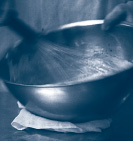
There are probably a million versions of this dish, and the sauce varies widely. My version is mildly spicy and abundantly dotted with crispy cashews so you’ll encounter their crunch in nearly every bite. The sauce, added during the last few minutes of cooking, is made with hoisin and orange zest, a terrific combination that contributes a salty sweetness to the taste and also gives the chicken a nicely burnished reddish brown color. For the best flavor, marinate the chicken for a good long time—ideally, overnight in the refrigerator. But if you’re pressed for time, marinate it for 2 hours and you’ll still end up with good results.
Partially cooking the marinated chicken morsels briefly in oil, then stir-frying them with aromatics such as garlic and ginger, is a variation on a classic Chinese technique called velveting. It ensures tenderness and gives the chicken a luxurious slippery and satiny exterior. Serve with a big bowl of white rice. SERVES 6 TO 8
3 tablespoons cornstarch
⅓ cup plus 2 tablespoons good-quality soy sauce, such as Kikkoman
1 tablespoon Chinese black vinegar or balsamic vinegar, or more to taste
1 tablespoon dry sherry
1½ teaspoons sugar
1 teaspoon Asian sesame oil
3 whole skinless, boneless chicken breasts (about 2¼ pounds total), cut into ½-inch dice
6 cups peanut oil, for deep-frying
1½ cups (about 8 ounces) raw cashews
2 large cloves garlic, minced
1 tablespoon grated fresh ginger
Grated zest of 2 large oranges
½ teaspoon hot red pepper flakes, or more to taste
½ cup hoisin sauce
½ cup Chicken Stock (page 39) or canned low-sodium chicken broth
1 bunch scallions, white and green parts, trimmed and cut into 1-inch lengths
1. Place the cornstarch, 2 tablespoons of the soy sauce, 1 tablespoon of the vinegar, the sherry, 1 teaspoon of the sugar, and the sesame oil in a large bowl and whisk to blend. Add the diced chicken and toss thoroughly to coat. Refrigerate, covered, for at least 2 hours and up to 12.
2. Heat the oil in a wok or large, heavy saucepan until it registers 325°F on a deep-fry thermometer. Drop a test cashew in the oil; it should turn light brown in 2 to 3 minutes. Add all the cashews to the oil and fry until lightly browned, then remove them with a slotted spoon or skimmer and place on paper towels to drain; be careful not to brown the nuts too much, because they will continue to cook for a couple of minutes after they are removed from the oil.
3. Drain the chicken, then add it in batches to the hot oil. Fry until the pieces are just partially cooked but not yet browned, about 1 minute; stir constantly to keep the pieces from sticking together. Using the slotted spoon or skimmer, remove each batch from the oil to a colander set over a plate or baking sheet to drain.
4. Drain all but 3 tablespoons of the oil from the wok (see Note) and set the wok over medium-high heat. When hot but not smoking, add the garlic and ginger and stir-fry rapidly until aromatic and just slightly browned, about 15 seconds, then add the grated orange zest and pepper flakes. Stir-fry for about 10 seconds, then return the chicken to the wok and stir-fry for about 3 minutes. Add the cashews and stir-fry for 2 minutes more. Add the remaining ⅓ cup soy sauce, remaining ½ teaspoon sugar, the hoisin sauce, and chicken stock and bring to a boil, stirring.
5. Remove the wok from the heat and taste for seasoning, adding more soy or hoisin or perhaps a splash more black vinegar. Add the scallions and toss, then transfer to a serving dish and serve immediately.
Note: The leftover oil may be cooled and strained and reserved for frying at another time.


The chopped vegetables in this gumbo, significantly less brothy than most versions, meld with the roux to form a rustic, thick sauce with plenty of substance and character. The gumbo is then additionally thickened with okra or filé powder (ground dried sassafras leaves). If okra is used, it cooks along with the other ingredients, but the filé powder is stirred into the gumbo at the last moment, just as the pot is removed from the heat. I prefer to use filé because it imparts a tantalizing undercurrent of smokiness to the stew.
A bowl of rice is the classic gumbo accompaniment, but for a change of pace we enjoy it served over Cornmeal-Onion Biscuits (page 380). Split a biscuit and put the bottom half in a bowl, spoon lots of gumbo over it, then top with the other biscuit half. SERVES 10 TO 12
12 whole chicken legs (about 6 pounds total), drumsticks and thighs separated
⅔ cup canola or other vegetable oil
⅔ cup all-purpose flour
3 large onions, chopped (see Note)
4 medium ribs celery, trimmed and chopped (see Note)
3 large red bell peppers, stemmed, seeded, and chopped (see Note)
2 large green bell peppers, stemmed, seeded, and chopped (see Note)
2 bunches scallions, white and green parts, trimmed and chopped (see Note)
½ cup chopped ham
¼ cup diced bacon
2 large cloves garlic, minced
3 bay leaves
1 tablespoon coarse (kosher) salt, or to taste
2 teaspoons cayenne pepper, or to taste
1 tablespoon freshly ground black pepper, or to taste
1 tablespoon freshly ground white pepper, or to taste
4 cups Chicken Stock (page 39) or canned low-sodium chicken broth, or enough to cover
1 tablespoon filé powder
1. Rinse the chicken under cold running water, removing any excess fat. Pat dry with paper towels.
2. Heat the oil in a Dutch oven or large, heavy pot over medium-high heat. When it just begins to smoke, add only enough chicken drumsticks and thighs to fit into the skillet without touching and sauté until well browned on all sides, 8 to 10 minutes total. Using tongs, transfer the pieces to a platter and set aside while you sauté the remaining pieces in batches, as necessary.
3. When all the chicken has been removed from the pot, reduce the heat a bit and sprinkle the flour over the drippings, whisking rapidly to blend. Cook the roux, whisking constantly, until it achieves a peanut-buttery color, 5 to 6 minutes. Watch carefully; you don’t want to burn the roux. As soon as the roux is the right color, add the chopped vegetables along with the ham, bacon, and garlic; be careful, because steam will be created on contact with the very hot roux. Reduce the heat to very low and sauté the mixture gently, stirring frequently, until the vegetables start to soften and give off a little liquid, about 5 minutes.
4. Add the bay leaves, salt, cayenne, black and white peppers, and thyme and stir well to mix. Add 4 cups chicken stock, stirring well to mix, then return the chicken legs to the casserole. Add more stock, if necessary, to cover the chicken and bring to a boil over high heat, stirring occasionally. Reduce the heat to low and simmer, uncovered, until the chicken is very tender and almost but not quite falling off the bone, 25 minutes.
5. Using a slotted spoon, transfer the chicken legs to a platter and set them aside. Increase the heat under the pot to high and cook the sauce, uncovered, until it’s reduced to a light sauce consistency, 10 to 15 minutes. Return the chicken to the pot and cook until heated through, 3 to 5 minutes. Remove the pot from the heat, stir in the filé powder, and let stand for 5 minutes before transferring to a serving dish.
Note: Vegetables chopped in a food processor usually come out too mushy for most dishes—however, that’s just the texture you want for this gumbo. So if you’ve got a processor, use it to chop away.
chicken for salads
Roast chicken makes the best chicken salad because it’s the most flavorful, but if you don’t feel like turning on the oven, use poached chicken breasts instead (see below). The salad recipes here call for 6 cups of diced chicken. As a rule of thumb, you can figure that a 6-pound roaster (or two 3- to 3½-pound broiler-fryers) will yield about 6 cups of cooked, boneless diced chicken. Four whole bone-in poached chicken breasts (4 to 4½ pounds) will also yield about 6 cups of diced chicken.
For the most flavorful poached chicken, use bone-in breasts with the skin on. Place the breasts in a large, deep saucepan or a stock-pot. Add 1 small carrot, scrubbed and sliced; 1 small onion, sliced; 1 bay leaf; 5 or 6 whole black peppercorns; and enough water to cover by about ½ inch. Bring to a boil over medium-high heat, then reduce the heat to low and simmer, partially covered, until the chicken is tender, about 10 minutes. Remove the pan from the heat and let the chicken cool in the broth. When the chicken is cool, remove it from the broth to a cutting board. Remove the skin and bones and cut the meat into bite-size pieces.
Be sure to strain the poaching liquid before storing it for another use (as a base for soup or for poaching more chicken). It will keep in the refrigerator for up to a week in a tightly covered container (be sure to bring it to a boil every 2 to 3 days; cool and refrigerate again). It can also be frozen for about a month.

The difference between a ho-hum chicken salad and an extraordinary one is a flavor-packed homemade mayonnaise. A favorite at our staff meals, this salad’s terrific taste and scenic yellow hue are appetizing proof that the few extra minutes making the Curried Mayonnaise (page 361) is time well spent.
Chicken salads are simple to make and endlessly adjustable. Toss together all the ingredients of this one and present it on a platter, garnished with tomato, cucumber, alfalfa sprouts, and some avocado slices, or use the salad as a sandwich filling. Just don’t bring it along to a Yankees game as a snack, as Melicia once did—the hot-dog eaters will never let you hear the end of it. SERVES 4 TO 6
6 cups diced cooked chicken (see box)
1 cup Curried Mayonnaise (page 361)
5 scallions, white and green parts, trimmed and thinly sliced
¾ cup walnut pieces
¼ cup dried currants
Coarse (kosher) salt and freshly ground black pepper, to taste
A few dashes of Tabasco sauce
Squeeze of lemon juice
Toss the diced chicken with the mayonnaise, scallions (save a bit to sprinkle on top if you’ll be serving the salad on a platter), walnuts, and currants. Season with salt, pepper, Tabasco sauce, and a squeeze of lemon and toss well to mix. Serve immediately.
The subtle, faintly aniselike flavor of homemade Tarragon Mayonnaise (page 362) contributes a bright and refreshing French accent to the tender pieces of chicken in this salad. Other fresh herbs such as basil, lemon thyme, cilantro, and chives can be used in place of the tarragon, if you wish. SERVES 4 TO 6
6 cups diced cooked chicken (see page 186)
1 cup Tarragon Mayonnaise (page 362)
8 ounces green beans, steamed and chilled, for garnish 1 cucumber, peeled, halved, seeds removed, and sliced, for garnish
1 large fresh, ripe tomato, sliced, for garnish
1. Place the chicken and mayonnaise in a large bowl and toss well to mix. Set aside while you prepare a serving platter.
2. Artfully arrange the green beans, cucumber slices, and tomato slices around the outside edge of the platter. Spoon the chicken mixture into the center and serve immediately.
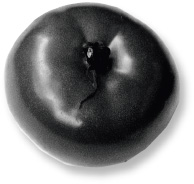

The intriguing combination of ingredients in this marinade creates extraordinarily tender and tasty wings. Hoisin sauce, honey, and orange juice give the wings a deliciously dark, caramelized character, while the wine vinegar and soy and chili sauces balance the sweetness. Strong-flavored Chinese black soy sauce (sometimes called double black soy sauce) is a pivotal ingredient. It’s used to add deep color and textural substance to dishes in which it’s important that a sauce adhere well to slippery ingredients such as noodles or chicken. Good brands to look for are Pearl River Bridge and Koon Chun.
This marinade works equally well with bone-in chicken breasts, legs, and thighs, but it’s especially good with wings served with a big bowl of room-temperature Soba Salad (page 337). SERVES 6
6 pounds chicken wings
3 large oranges
2 cups good-quality regular soy sauce, such as Kikkoman
½ cup red wine vinegar
¼ cup hoisin sauce
¼ cup honey
2 tablespoons black soy sauce
1 tablespoon Chinese chili sauce with garlic
1 tablespoon grated fresh ginger
2 large cloves garlic, minced
1. Trim the tips from the wings and discard or save for another purpose, such as making stock. Rinse the remaining wings under cold running water, then drain and pat dry with paper towels.
2. Grate the zest only (no white pith) from the oranges, then cut the oranges in half and squeeze the juice; you should have about 1 cup. Combine the grated zest and juice in a large bowl. Add the regular soy sauce, vinegar, hoisin sauce, honey, black soy sauce, chili sauce, ginger, and garlic and whisk thoroughly to blend. Add the chicken wings and toss to coat completely, then refrigerate, covered, for at least 8 hours and up to 24.
3. When you’re ready to cook, preheat a grill.
4. When the grill is moderately hot, drain the chicken wings and arrange them on the grill rack. Cook until nicely browned and cooked through, about 10 minutes on each side. Serve with plenty of paper napkins.

hoisin sauce
Simultaneously spicy and sweet, mahogany-colored hoisin sauce is a jamlike mixture of fermented soybean paste, garlic, sugar, and five-spice powder with a hint of dried chile. You’ve no doubt tasted this terrifically flavorful, somewhat salty sauce many times spread on the thin pancakes that accompany mu shu pork and Peking duck (it’s sometimes known as Peking sauce). Hoisin is often used as a glaze or basting sauce for grilled or roasted meats and poultry and as an ingredient in marinades and dressings. Look for glass jars of hoisin at Asian markets and large supermarkets; good brands include Koon Chun, Pearl River Bridge, and Kimlan. Stored in its glass jar, hoisin will keep indefinitely in the refrigerator.

When Buffalo wings first made an appearance at a staff meal, they instantly became a point of contention, sparking endless arguments on the right, the only the way to prepare them. Finally, after intense consultations with our resident Buffalonian, the following method was agreed upon and is our official recipe. The butter-to-hot-sauce ratio can be tinkered with, depending on how spicy (or unspicy) you like your wings. A higher proportion of butter to hot sauce, for example, makes milder, less spicy wings. It’s the use of Frank’s RedHot Hot Sauce, a smooth, Louisiana-style sauce with just the right amount of heat and vinegar, that makes these wings so authentic tasting. It’s sold in supermarkets across America so you should have no trouble finding it, but if your local store doesn’t carry it, give the company a call at (800) 841-1256. We have no compunctions about devouring a pound of wings per person at dinner (that’s about 8 to 10 wings) as long as there’s a salad, too. And since it’s de rigueur, there are also plenty of crisp, chilled celery sticks and creamy Blue Cheese Dressing on the table. SERVES 4 TO 8
4 pounds chicken wings
5 tablespoons unsalted butter
½ cup Frank’s RedHot Hot Sauce
4 cups vegetable oil, for deep-frying
4 large ribs celery, trimmed and cut into 3-inch sticks
Blue Cheese Dressing (page 357)
1. Trim the tips from the wings and discard or save for another purpose (such as making stock), then separate the remaining part of the wings at the joint. Rinse the wing pieces under cold running water, then drain and pat dry with paper towels.
2. Melt the butter in a small saucepan. Remove the pan from the heat and whisk in the hot sauce. Pour the mixture into a bowl deep enough to hold all the wings and set aside.
3. Heat the oil in a deep, heavy skillet or deep-fryer until it registers 375°F on a deep-fry thermometer. Add the wings, in batches so they won’t touch, and fry until they’re browned and quite crispy, 2 to 3 minutes per side. Transfer to paper towels to drain while you fry the remaining wings.
4. When all the wings have been fried, toss them thoroughly with the butter and hot sauce mixture. Transfer to a serving platter, arrange the celery sticks around them, and serve immediately, accompanied by the sauce. Pass the napkins!
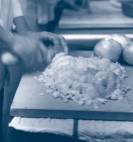
Preparing this recipe always brings back a flood of family memories. When my parents entertained at home, my assigned tasks were to prepare the Manhattans and to turn the crank of the meat grinder for my mother when she made the chopped chicken liver. I regard myself as the keeper of the flame of the chopped liver recipe and try to make it for family get-togethers, especially if my brother Jonathan is in town. It’s essential to use rendered chicken fat, also called schmaltz, for authentic flavor. The radishes add bite to the mixture and create a counterpoint to the richness of the liver and schmaltz. Serve this as a spread for matzoh or crackers. A schmear of chopped chicken liver on rye bread makes a great midafternoon snack. MAKES A GOOD-SIZE BOWL
1 large sweet onion, preferably Vidalia, Maui, or Walla Walla
2 tablespoons plus ½ cup rendered chicken fat (see box, page 143)
1 teaspoon minced garlic
4 large eggs, hard cooked and peeled
6 red radishes, trimmed
Plenty of coarse (kosher) salt and freshly ground black pepper
1. Clean the chicken livers by cutting away any greenish parts and bits of fat and connective tissue. Peel the onion and cut it into pieces that will fit through your meat grinder.
2. Melt 2 tablespoons of the chicken fat in a large, heavy skillet over medium heat. Add the garlic and sauté, stirring, until aromatic but not browned, about 1 minute. Increase the heat to high, add the chicken livers, and sauté, stirring frequently, until medium rare (browned outside but still rosy inside), about 3 minutes. Transfer the livers to a colander to drain and cool.
3. When they’re cool, pass the livers, onion, eggs, and radishes through a meat grinder, using the coarse blade. Alternatively, you can chop everything by hand.
4. Transfer the ground mixture to a bowl and add the remaining ½ cup chicken fat and salt and pepper. Stir gently but thoroughly to mix, then taste and adjust the seasoning. The mixture should be nicely salty, peppery, and schmaltzy.
fat equals flavor
Although fat has become distinctly unfashionable in the past decade, professional cooks have always known that the presence of some fat is fundamental to flavor. As I cook in my kitchen at Chanterelle and at home, I take advantage of the succulence of duck fat, the fruitiness of a good olive oil, the nuttiness of butter, the fullness of rendered chicken fat, and the robustness of bacon drippings. Fat makes food taste good by adding flavor, and by acting as a conduit for the good tastes that should journey across the palate with every mouthful. In baking, fat tenderizes, in sautéing it assists the transference of heat from pan to food, and in sauces and dressings it is a flavor enricher and emulsifier that also creates a beguiling appetizing sheen. I feel so strongly about fat that I once had staff sweatshirts printed with the motto “Fat = Flavor.”
a waltuck family feast
One of the nicest things about owning your own restaurant is that you have room to invite as many people as you want for a holiday meal. At Thanksgiving we’re surrounded by relatives and friends, plus any “orphans” who aren’t traveling home to celebrate. First-timers at our Thanksgiving meal bring a special outsider energy that balances things—after all, they haven’t heard the complete repertoire of family jokes and stories before!
Karen and I set up a very long table in the middle of the restaurant, and she creates one of her magical-looking flower arrangements for it. We scatter books and toys for the kids everywhere, and also make sure there’s an ample supply of paper and crayons. Our daughter, Sara, takes the beverage orders, while our son Jake’s job is to simply be himself. My cousin Linda takes charge of dessert, and there are always delicious honey cakes and traditional pumpkin pies along with a luxurious assortment of Chanterelle’s sorbets and ice creams.
I love having the whole kitchen to myself, free of the rush of restaurant service. For me, relaxed and unharried time alone at Chanterelle is a luxury, so I seize this opportunity to savor the solitude of my kitchen. Over the years I’ve tried to introduce unorthodox dishes at our Thanksgiving table, things like venison or small birds in place of the traditional turkey, but my innovations have consistently met with such firm resistance that I’ve returned to roast turkey. I make a huge array of appetizers, including Ginger Pickled Salmon with Wasabi Sauce (page 214) and my brother Jonathan’s favorite Chopped Chicken Liver (page 192). There are big bowls of Everyday Mashed Potatoes (page 334), giant casseroles of Cauliflower Gratin (page 310), and platters heaped with roasted root vegetables.
One of the advantages of having a powerful industrial-strength restaurant dishwasher with long spray hoses is that when the feast is finished, everyone volunteers to help clean up!

After some attempts at being innovative, I’ve come to be a believer in a lavish Thanksgiving meal that features turkey front and center. However, to be honest, I’m not a fan of turkey dark meat, so when I cook up the family bird I go for the breast. Lavishly rubbed with butter and the right selection of spices, the breast comes out moist and flavorful.
If you can’t find a 14-pound breast, two 7-pounders will work just as well. And if you’re a dark-meat fan, you can use this rub to flavor and roast a whole bird. The final roasting time will be different, but the taste will be just as delicious. SERVES 12 TO 14
1 cup canola or other vegetable oil
1 tablespoon coarse (kosher) salt
1 tablespoon sweet Hungarian paprika
1 tablespoon fresh lemon juice
2 teaspoons minced garlic
2 teaspoons freshly ground black pepper
1 whole turkey breast (about 14 pounds)
1. Preheat the oven to 400°F.
2. Combine all the ingredients except the turkey in a small bowl and whisk to combine.
3. Place the turkey in a large roasting pan skin-side up and generously rub the oil mixture over the entire breast.
4. Roast the turkey for 30 minutes, then baste with some of the remaining oil or with any juices that have accumulated in the bottom of the roasting pan. Reduce the oven temperature to 350°F and continue roasting for another hour. Baste the turkey and roast for 30 minutes more. The skin should be beautifully crisp, and the meat tender and juicy. Test for doneness by making a small incision in the thickest part of the roast. The juices should run clear. (An instant-read thermometer should register between 160° and 165°F when inserted in the thickest part of the breast.) If the turkey isn’t ready, baste again and continue roasting for another 15 minutes; then check again. Do be careful; you don’t want to overroast.
5. Remove the turkey from the oven and let it rest for 20 minutes before slicing and serving.

From the time she was five years old my daughter, Sara, and I have been cooking Thanksgiving dinner together. We arrive at Chanterelle many hours before anyone else. There is a pleasant quietness as we unlock the door, flick on the lights, and begin our chores snugly enveloped in the stillness. We start gathering ingredients and organizing things, then move on to making this stuffing. It’s a good, straightforward stuffing, filled with the earthy flavors of shiitake mushrooms, sausage, and fragrant fresh herbs. Although you could easily make it with good-quality white sandwich bread from the supermarket, I prefer to use thick-crusted, rustic white loaves from a bakery. MAKES ENOUGH STUFFING FOR A 20-POUND TURKEY
3 large loaves (about 1 pound each) white bread
5 tablespoons unsalted butter
3 tablespoons rendered chicken fat (see box, page 143) or additional unsalted butter
4 large onions, diced
3 tablespoons olive oil
3 pounds fresh shiitake mushrooms, stems removed and discarded, caps wiped clean with a dampened paper towel, and sliced (see Note)
3 pounds precooked chicken sausage (or your favorite sausage), cut into ½-inch dice
2 cups Chicken Stock (page 39) or canned low-sodium chicken broth, or as needed
5 large eggs, lightly beaten
2 tablespoons chopped fresh sage leaves
1 tablespoon chopped fresh thyme leaves
Coarse (kosher) salt and freshly ground black pepper, to taste
1. Preheat the oven to 350°F.
2. Cut the bread into 1-inch cubes and scatter them over as many baking sheets as it takes; you’ll probably need several. Toast the cubes in the oven until golden brown, about 15 minutes. Transfer to a large bowl and set aside.
3. Place 3 tablespoons of the butter and the chicken fat in a large skillet and melt over medium heat. Add the onions and sauté until softened but not browned, 5 to 8 minutes. Remove the skillet from the heat and add its contents to the bread in the bowl.
4. Wipe out the skillet and add the olive oil. Heat over medium-high heat and add the shiitakes. Sauté, stirring frequently, until the mushrooms are softened, about 10 minutes. Remove from the heat and add to the bowl.
5. Add the sausage to the bowl and toss with the other ingredients. Add the chicken stock ½ cup at a time to lightly moisten the mixture, then add the eggs, sage, thyme, salt, and pepper. Mix well.
6. Lightly oil a large casserole. Transfer the stuffing mixture to the casserole and dot the top with the remaining 2 tablespoons butter, cut into bits. Bake, covered, for 25 minutes. Then remove the cover and continue baking until the stuffing is nicely browned on top, 10 minutes more. Serve immediately.
Note: You can also use a mix of mushrooms in the stuffing—for example, 1 pound shiitakes and 2 pounds fresh cultivated white mushrooms. If you use white mushrooms, there’s no need to discard the stems; just trim them slightly.

The crisp skin of the roast duck in this curry provides a nice contrast to the creamy, flavorful coconut milk sauce that’s spooned over it just before serving. Coconut milk is an ideal base on which to build the complex flavors of classic Thai aromatics such as lemongrass, green curry paste, ginger, and kaffir lime leaves. Although duck is a perfect choice, the sauce is equally tasty with chicken or Cornish hens. For a vegetarian curry, omit the meat, increase the amount of squash, and add cauliflower and/or broccoli.
Marble-size green Thai pea eggplants, also used in chutneys and for pickling, are traditional in this curry. However, their bitterness is an acquired taste, and they’re difficult to obtain, even at Asian markets. In fact, many Thai restaurants use frozen peas as a substitute, and I do the same. They don’t have the same taste, of course, but they do add color to the curry. SERVES 2 TO 4
1 Pekin duck (about 5 pounds)
1½ tablespoons canola or other vegetable oil
6 stalks lemongrass, chopped (see page 236)
1 piece (3 inches) fresh ginger, unpeeled, cut into ⅛-inch-thick slices
2 teaspoons Thai green curry paste
1 large clove garlic, minced
3 cans (13 or 14 ounces each) coconut milk, preferably a Thai brand
10 fresh kaffir lime leaves (see box, page 15)
Juice of 2 limes
2 tablespoons Thai fish sauce (nam pla)
1 can (10 ounces) sliced bamboo shoots, drained
1 can (8 ounces) straw mushrooms, drained
2 medium red bell peppers, stemmed, seeded, and cut into julienne
1 small zucchini, cut lengthwise in half, then cut crosswise into ½-inch slices
1 small yellow squash, cut lengthwise in half, then cut crosswise into ½-inch slices
¼ cup frozen peas
Coarse (kosher) salt, to taste (optional)
4 cups cooked rice
1. Preheat the oven to 375°F.
2. Rinse the duck, inside and out, under cold running water, removing any excess fat and skin. Pat dry with paper towels. Cut the duck into 10 pieces (see box, page 159).
3. Place the duck parts, skin-side up, in a shallow roasting pan and roast until tender and the skin is browned and crisp, about 30 minutes.
4. While the duck is roasting, heat the oil in a medium-size, heavy, nonreactive saucepan over medium-low heat. Add the lemongrass, ginger, curry paste, and garlic and sauté, stirring frequently, until fragrant and softened but not browned, about 10 minutes.
5. Add the coconut milk, lime leaves, lime juice, and fish sauce. Bring to a boil over medium-high heat, then reduce the heat to low. Simmer, uncovered, until the sauce is slightly thickened and the flavors are blended, about 20 minutes.
6. Add the bamboo shoots, mushrooms, bell peppers, onion, zucchini, and yellow squash to the sauce. Bring to a simmer over medium heat, then reduce the heat slightly and simmer, uncovered, until the vegetables are almost tender, 10 to 15 minutes. Add the peas and simmer for 5 minutes longer. Remove the pan from the heat and taste for seasoning, adding salt if necessary.
7. When the duck is ready (see Note), arrange the pieces on a serving platter and spoon the sauce over them. Serve immediately, accompanied by rice.
Note: If the duck is ready before the sauce, don’t let it sit in the fatty roasting pan. Transfer the pieces to a platter and cover them lightly with aluminum foil to keep warm.
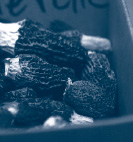
The basis for this dish is the same Broth for Red-Cooking used to make Chilled Red-Cooked Beef (page 65). The slight sweetness of the broth and the earthiness of the shiitakes create the perfect foil for the duck’s fatty richness. When the dish is reheated after chilling overnight in the refrigerator, you could add a few vegetables such as snow peas, broccoli florets, and green beans if you like. When I make this in the autumn, a perfect time to enjoy it, I sometimes substitute dried chestnuts for half of the dried shiitakes. The chestnuts should be soaked overnight in warm water to cover, then drained, left whole, and stirred into the casserole after it has been in the oven for 20 minutes. (If overcooked, they will fall apart.) Serve with Broccoli with Oyster Sauce (page 307) and a big bowl of plain white rice. SERVES 4
24 dried shiitake mushrooms
1 Pekin duck (5 to 5½ pounds)
2 tablespoons canola or other vegetable oil
6 cups strained Broth for Red-Cooking (page 67)
1. Place the shiitake mushrooms in a large bowl with very warm water to cover. Let soak for 30 minutes to soften. Lift the mushrooms from the water, leaving the grit behind. Leave the mushrooms whole, trimming away any stems. Set the caps aside. Strain the soaking liquid through a strainer lined with several layers of cheesecloth. Add to the casserole with the mushrooms in step 5 or cover, refrigerate, and save for use at another time.
2. Preheat the oven to 350°F.
3. Trim the excess fat and skin from the duck, then cut the duck into 10 pieces (2 drumsticks, 2 thighs, 2 wings, and 4 breast pieces; see page 159). Rinse under cold running water, then pat dry with paper towels.
4. Heat the oil in a large, heavy skillet over medium heat. When the oil is very hot but not yet smoking, add just enough duck pieces to fit into the skillet without touching and sauté until well browned on all sides, about 4 minutes per side. Using tongs, transfer the cooked duck to a large, nonreactive, ovenproof casserole or Dutch oven and set aside. Drain the fat from the skillet and sauté the remaining pieces, in batches if necessary, transferring the browned duck to the casserole and draining the fat from the skillet as you go along.
5. Pour the red-cooking broth over the duck and add the shiitakes. Over medium heat, bring the mixture to a simmer. Cover and transfer the casserole to the oven. Cook until the duck is tender, about 1 hour.
6. Remove the casserole from the oven and let the duck cool in the sauce for at least an hour. Then refrigerate the casserole overnight. The next day remove the layer of fat that has risen to the top. Gently reheat in the casserole on top of the stove or in a 300°F oven until warmed through.
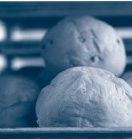
Certainly the greatest pleasure for a cook is knowing that his or her dishes are appreciated and admired. But other smaller, more casual delights are for the cook’s taste buds only. Since two of my favorite “food groups” are fat and salt, preferably in combination, it’s not surprising that one of my greatest private rewards is tearing off a chunk of bread and sopping up leftover duck fat from the pan after I’ve made duck confit. The only higher reward might be those irresistible little bits of caramelized duck skin that cling to the sides of the pan.
The term confit comes from the French confire, which means “to preserve.” A confit of pork, goose, lamb, chicken, or even rabbit can be made using the basic technique here, but duck is the most traditional and, I think, the tastiest choice—slightly salty and very tender with a wonderfully concentrated flavor. I use Moulard duck legs, which are larger and meatier than Pekin ones. The duck legs are first salt-cured to draw out their juices. Many cooks add a lot of flavorings to the cure, but I prefer to keep it simple, using only salt and pepper. Then the legs are gently simmered in rendered fat until the meat is just shy of falling off the bone. Once cooked, the meat is transferred to a glass or ceramic storage container and the cooled fat, which acts as a preservative, is ladled over it. Tightly covered, confit can be stored for up to 6 months in the refrigerator, during which time the flavor continues to improve. Try to resist eating the confit right away—it’s far better to let it age for at least a week, preferably two, before indulging.
Duck confit can be served roasted or grilled; it can be simmered in beans or soup; and, of course, it is often an ingredient in cassoulet. The flavor is very compatible with lentils, especially Warm Lentil Salad (page 322), braised cabbage, and fruits such as apples, pears, and prunes. SERVES 8
8 duck legs, preferably Moulard
5 tablespoons coarse (kosher) salt
1 tablespoon whole black peppercorns
8 cups rendered duck or goose fat (see box)
1. Place the duck legs in a large, nonreactive glass or ceramic baking dish and toss with the salt and peppercorns. Cover and let cure in the refrigerator for 24 hours.
2. Remove the duck from the baking dish. Rinse off the salt and pepper under cold running water and pat the duck dry with paper towels.
3. Melt the duck fat in a large, heavy pot over low heat. Add the duck legs (they should be completely submerged in fat), increase the heat to medium, and bring the fat to a very slight simmer. Simmer (see Notes) until the duck is very tender but still holding together, about 2 to 2½ hours (1 to 1½ hours for Pekin legs).
4. Using a slotted spoon, gently transfer the duck to a nonreactive glass, ceramic, or stainless-steel storage container. (If your refrigerator is on the small side, you may want to use two containers.) When the fat in the saucepan has cooled to room temperature, ladle it over the duck to cover by at least 1 inch. Cover and refrigerate for at least 1 week before serving.
5. To serve, let the container of confit sit out of the refrigerator at room temperature until the fat softens enough to allow you to remove a duck leg without tearing it.
6. Preheat the oven to 375°F.
7. Place the duck legs on a rimmed baking sheet and roast until the skin is nice and crisp, 20 to 25 minutes (see Notes). If necessary, place the duck under the broiler for a few seconds for further crisping. Serve immediately.
Notes: If you prefer, the duck can be simmered in an ovenproof casserole or saucepan in a 275°F oven for 2 to 2½ hours.
If you wish, the duck can be warmed and crisped in a cast-iron skillet over medium heat for 15 to 20 minutes. Frugal cooks who want a supply of duck fat for use later should pour off and reserve the excess fat that melts off the duck after the first 2 or 3 minutes that it’s heated in the pan. (Frying sliced potatoes in this fat is one of life’s great treats.)
fat for confit
A supply of rendered duck fat is essential for making duck confit. If you prepare duck occasionally and are accustomed to saving the drippings, skin, and trimmed fat in the freezer, you may want to render your own duck fat. To do this, follow the instructions in the box on page 143. If you have some duck fat but not enough for the recipe, supplement it with rendered pork or goose fat or lard (a 1-pound package of lard equals 2 cups). It’s not advisable to use chicken or lamb fat.
Small tubs of duck fat are available at some specialty food stores and meat markets or by mail.
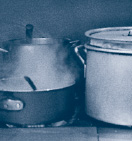
For our big annual Chanterelle staff picnic up in Woodstock, one of the first things I do is fire up the gigantic rented grill set up in our backyard and fill it with marinated quail. These tiny game birds (you’ll need 2 per diner) are naturally tender but so delicately flavored that an assertive marinade works best. This slightly sweet one, which I jokingly refer to as Vermont teriyaki sauce since it’s made with maple syrup, gives the cooked birds an attractive mahogany-colored sheen. Take care not to let the grill get too hot, though, because the marinade caramelizes quickly.
Quail have become easier to find in the past few years, so you shouldn’t have difficulty buying fresh or frozen ones (defrost in the refrigerator overnight); either works for this recipe. If you’re buying fresh quail from a butcher, it’s nicer to have them boned. They’ll leave in the tiny bones in the wings and legs but remove them from the breast and back; the cooking time is the same as for unboned birds. Cut into pieces, boned grilled quail are perfect finger food when you’re entertaining. SERVES 4
¼ cup good-quality soy sauce, such as Kikkoman
¼ cup balsamic vinegar
¼ cup plus 1 tablespoon maple syrup
1 tablespoon chopped fresh ginger
1 teaspoon Asian sesame oil
Soba Salad (page 337)
3 bunches scallions, left whole, root ends trimmed
1 tablespoon canola or peanut oil
1. Rinse the quail, inside and out, under cold running water and pat dry with paper towels. Halve each lengthwise through the breast.
2. Combine the soy sauce, vinegar, maple syrup, ginger, and sesame oil in a nonreactive bowl and whisk to combine. Pour the marinade into a large, flat-bottomed, nonreactive dish large enough to hold the quail in one layer. Add the quail and turn once to coat. Cover with plastic wrap and refrigerate for 8 hours or overnight, turning the birds in the marinade from time to time.
3. When you’re ready to cook the quail, preheat the grill or broiler. Remove the quail from the marinade and drain them well, but don’t pat dry. Grill or broil over medium to low heat until the skin is nicely browned and the meat is just cooked through, about 3 to 4 minutes per side.
4. While the quail are grilling, arrange the salad in a mound in the center of a large platter. When the birds are cooked, set them around the edge of the noodles.
5. Toss the scallions in the oil and grill at high heat until wilted and slightly blackened, about 3 minutes, turning as needed. Drape the scallions over the bed of noodles to garnish. Serve immediately or at room temperature.

I prefer to prepare this tender rabbit dish with legs only (the hind legs are the meatiest if you have a choice), which are very well suited to braising. If you use whole cut-up rabbits, be aware that the various pieces have different cooking times. Loins, for example, will cook faster than legs. You’ll need to check the pieces as they cook so that each is removed from the pan as soon as it’s done.
Although assertively flavored, the Dijon mustard sauce is quite elegant. If you like, you can eliminate the cream and finish the sauce by simply whisking in several tablespoons of unsalted butter. Sautéed mushrooms or a handful of pearl onions add delicious taste and texture to the sauce. This dish can be made 2 or 3 days ahead, but be sure to add the herbs just before serving so they taste fresh. Serve the rabbit with boiled potatoes or buttered noodles to swirl around in the satiny sauce. SERVES 6
8 rabbit hind legs (12 to 14 ounces each)
¼ cup canola or other vegetable oil
2 cups dry white wine
3 tablespoons unsalted butter
2 medium onions, chopped
2 large cloves garlic, minced
2 tablespoons all-purpose flour
2½ quarts Chicken Stock (page 39) or canned low-sodium chicken broth
3 bay leaves
1 small bunch fresh thyme sprigs
3 cups heavy (or whipping) cream
¼ cup Dijon mustard
Coarse (kosher) salt and freshly ground black pepper, to taste
2 tablespoons chopped mixed fresh herbs or fresh flat-leaf parsley leaves
1. Rinse the rabbit legs under cold running water, then drain and pat dry with paper towels.
2. Heat the oil in a large, heavy, nonreactive skillet over medium-high heat. When it’s almost smoking, add half the rabbit legs and sauté until well browned on all sides, about 5 minutes per side. Using tongs, transfer the legs to a platter and set aside while you brown the remaining legs.
3. When all the legs have been removed from the skillet, carefully add the wine and bring to a boil over high heat, scraping up the browned bits from the bottom of the pan. Cook until the wine is reduced by a third, 3 to 5 minutes, then remove the skillet from the heat and set aside.
4. Melt the butter in a Dutch oven or large, heavy pot over medium-low heat. Add the onions and garlic and sauté gently, stirring occasionally, until the onions are softened but not browned, 6 to 8 minutes. Sprinkle the flour over the contents of the pot and reduce the heat to low. Cook, stirring frequently, until the mixture gives off a nutty aroma but isn’t browned, about 10 minutes.
5. Add the chicken stock, reduced white wine, bay leaves, and thyme and bring to a simmer over medium heat. Add the rabbit legs, along with any accumulated juices, to the pot and, when the liquid returns to a simmer, cook, partially covered, until the rabbit is tender, 45 minutes to 1 hour.
6. Using tongs or a slotted spoon, transfer the rabbit legs to a platter and set aside. Remove and discard the bay leaves and thyme. Bring the liquid to a boil over high heat and cook, uncovered, until strongly flavored and slightly thickened, about 15 minutes. Whisk in the cream, then return to a boil and cook, uncovered, whisking occasionally, until the liquid is reduced by about a third and a light, saucelike consistency is achieved, about 15 minutes.
7. Whisk in the mustard, then return the rabbit to the sauce and heat through, about 5 minutes. Season with lemon juice and salt and pepper, then stir in the herbs. To serve, transfer the rabbit to a platter and spoon the sauce over.

Rabbit is an accommodating meat, leaner than chicken, with a fine, somewhat firmer texture. Any of the braised chicken recipes in this chapter can be made with rabbit, especially rabbit legs. Over the years our staff has enjoyed enough variations on rabbit stew to prove to me that once the initial skepticism about rabbit is transcended, it is universally enjoyed. Serve this gutsy, olive-y stew with a simple starch side dish like Couscous (page 94), roast potatoes, fettuccine, orzo, or polenta. SERVES 6 TO 8
8 rabbit hind legs (12 to 14 ounces each)
½ cup extra-virgin olive oil
4 medium onions, sliced
4 large cloves garlic, minced
2 tablespoons all-purpose flour
¼ cup canola or other vegetable oil
1 bottle (750 ml) dry white wine
6 cups Chicken Stock (page 39) or canned low-sodium chicken broth
1 can (28 ounces) whole tomatoes, drained
¼ cup brandy
1 tablespoon olive paste (see page 81)
5 sprigs fresh thyme
5 bay leaves
½ teaspoon dried oregano leaves
2 cups black olives, preferably Kalamata, pitted if desired
Coarse (kosher) salt and freshly ground black pepper, to taste
Red wine vinegar, to taste (optional)
1. Rinse the rabbit legs under cold running water, then pat dry with paper towels. Set aside.
2. Heat the olive oil in a Dutch oven or large, heavy pot over low heat. Add the onions and garlic and sauté gently, stirring occasionally, until the onions are softened but not browned, about 10 minutes. Stir in the flour and cook, stirring occasionally, until just lightly browned; don’t let it color any more than this.
3. Meanwhile, heat the canola oil in a large skillet over medium-high heat. When it’s almost smoking, add half the rabbit legs and sauté until well browned on all sides, 8 to 10 minutes per side. Using tongs, transfer the legs to a platter and set aside while you brown the remaining legs.
4. When all the legs are removed from the skillet, pour off and discard the drippings. Add 1 cup of the wine to the skillet and carefully bring to a boil over high heat, scraping up the browned bits in the bottom of the pan. Pour the mixture into the pot with the onions and garlic. Add the remaining wine, the chicken stock, tomatoes, brandy, olive paste, thyme, bay leaves, and oregano. Bring to a boil, stirring, over high heat, then reduce the heat to low to maintain a steady simmer.
5. Add the rabbit legs and, when the mixture returns to a simmer, cook, partially covered, until the rabbit is quite tender, about 45 minutes.
6. Using tongs or a slotted spoon, remove the rabbit legs to a platter. Increase the heat under the pot to high and bring to a boil. Cook, uncovered, until the sauce has reduced by about one third, about 15 minutes. Return the rabbit legs to the casserole, along with the olives. Reduce the heat to low and continue cooking, uncovered, until the sauce has thickened somewhat further and the olives and rabbit are heated through, about 5 minutes.
7. Remove from the heat and discard the bay leaves and thyme sprigs. Season with salt and pepper, adding a little red wine vinegar if needed to balance the flavors. Serve immediately, right from the casserole.
